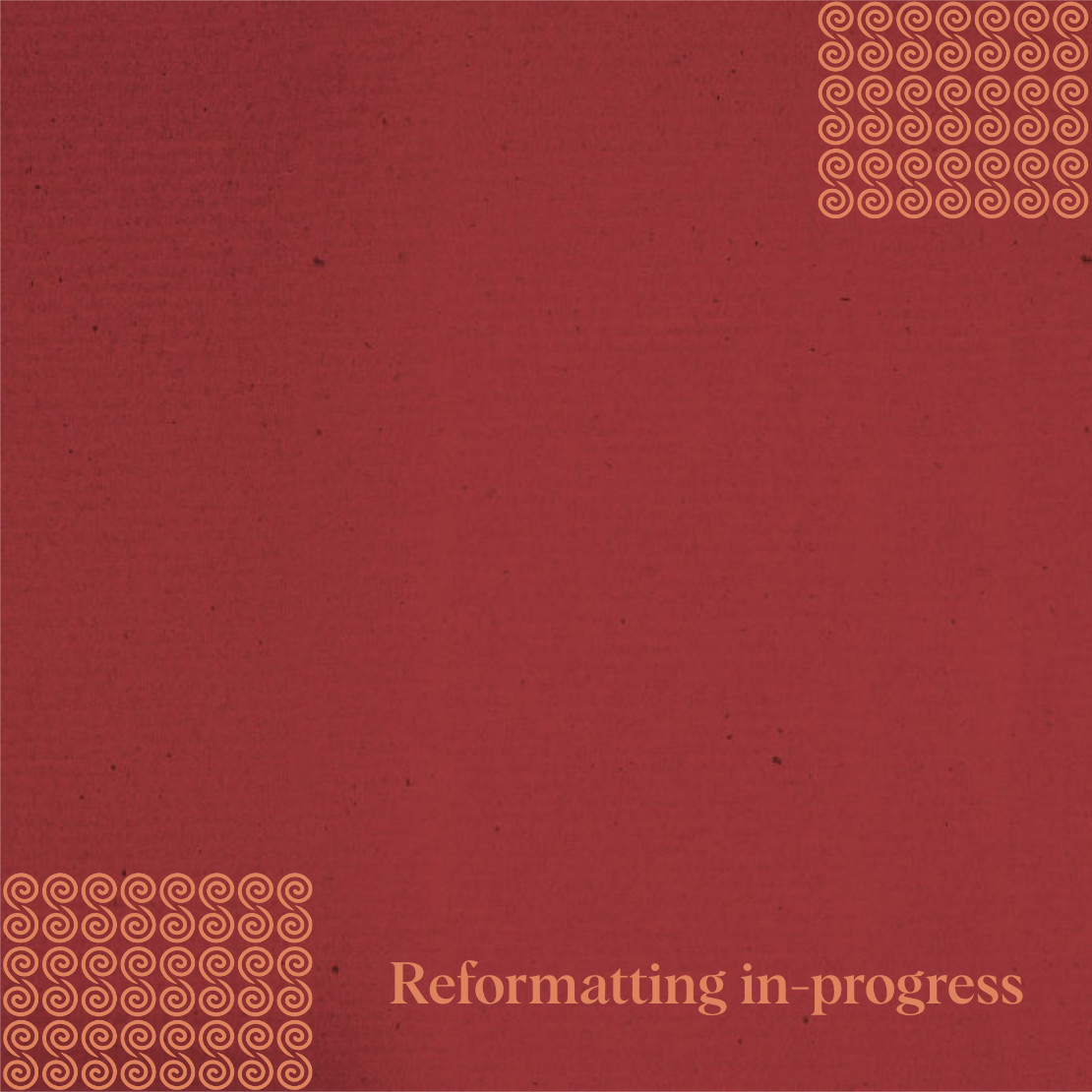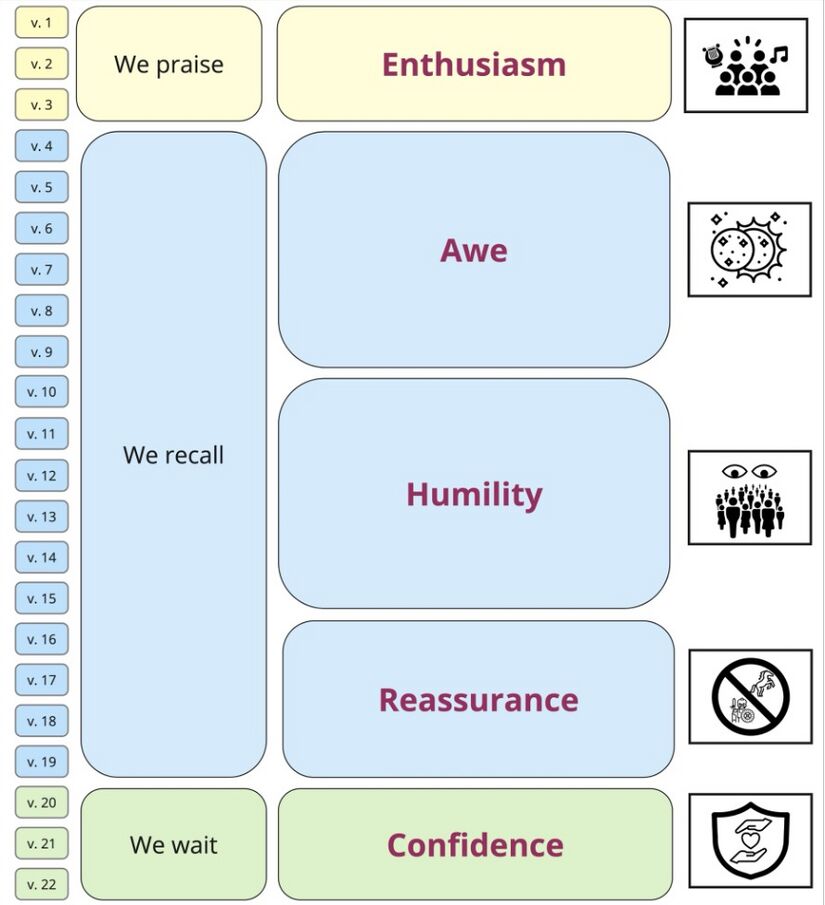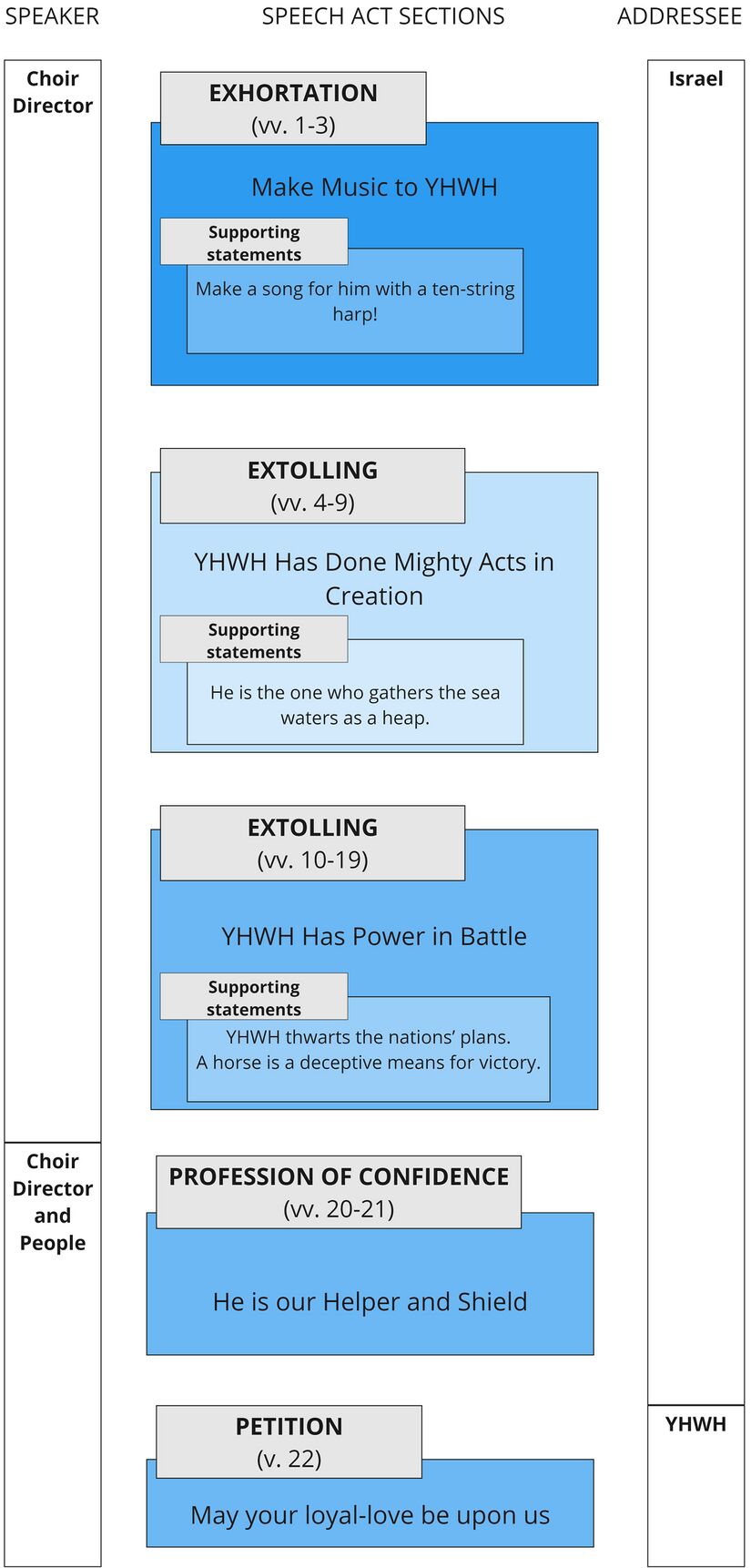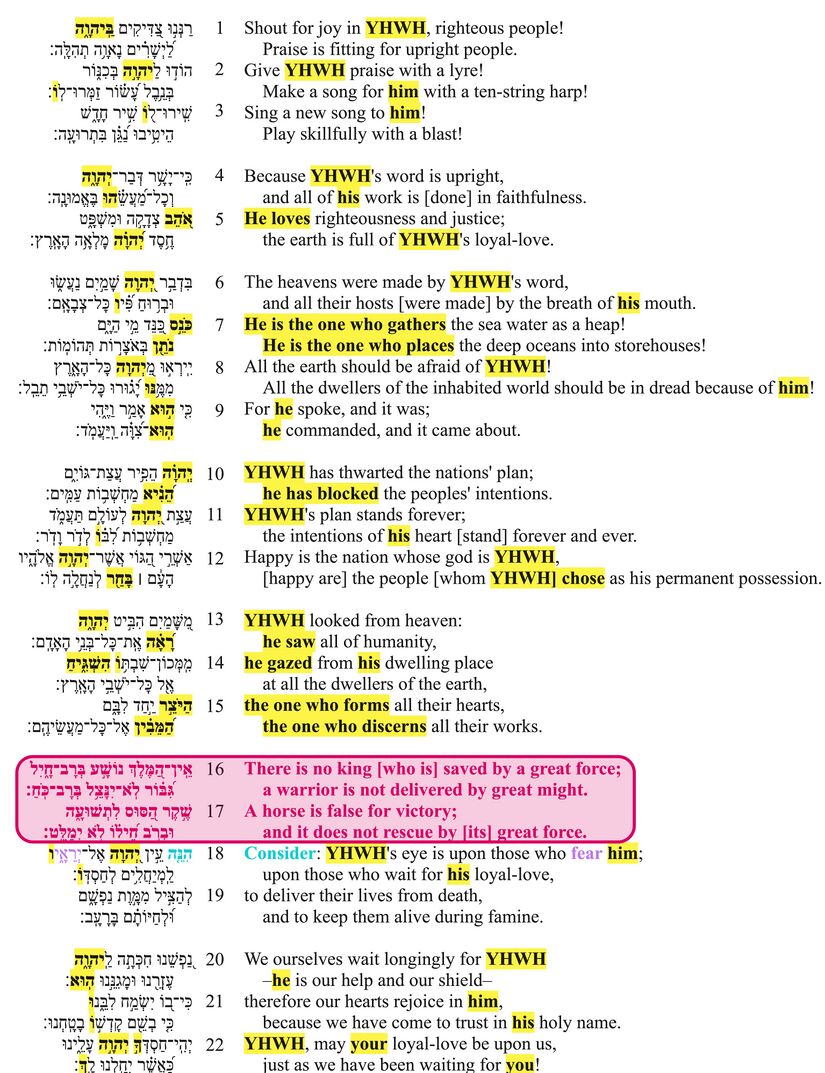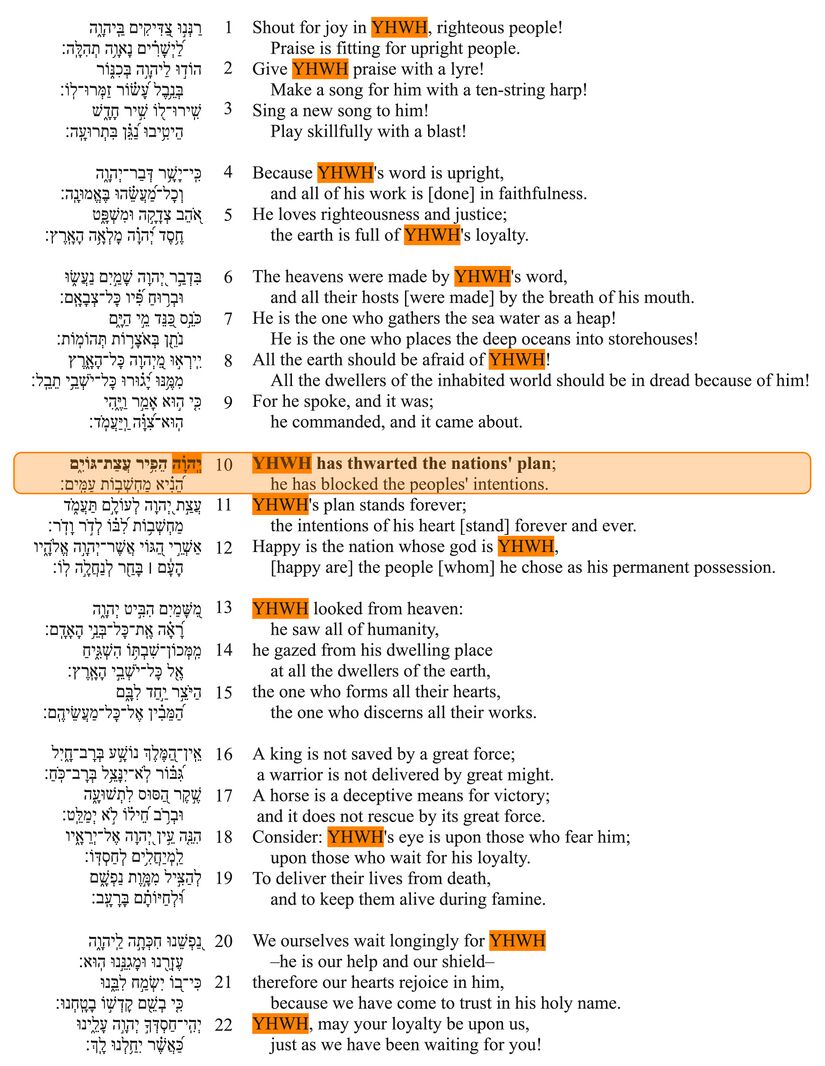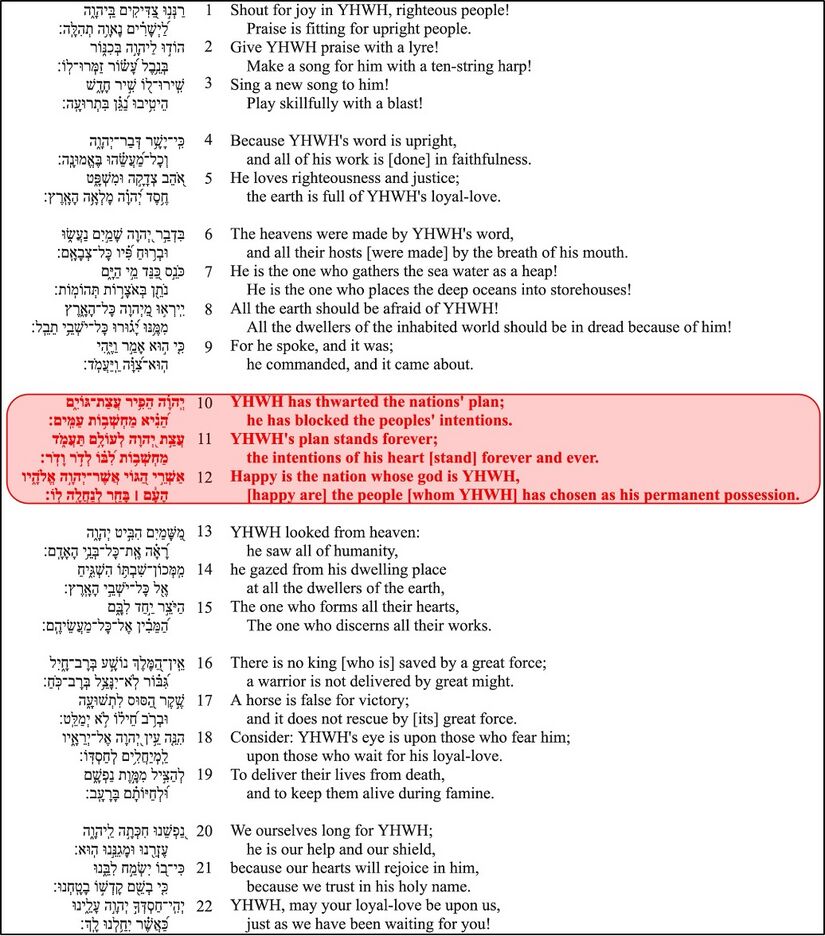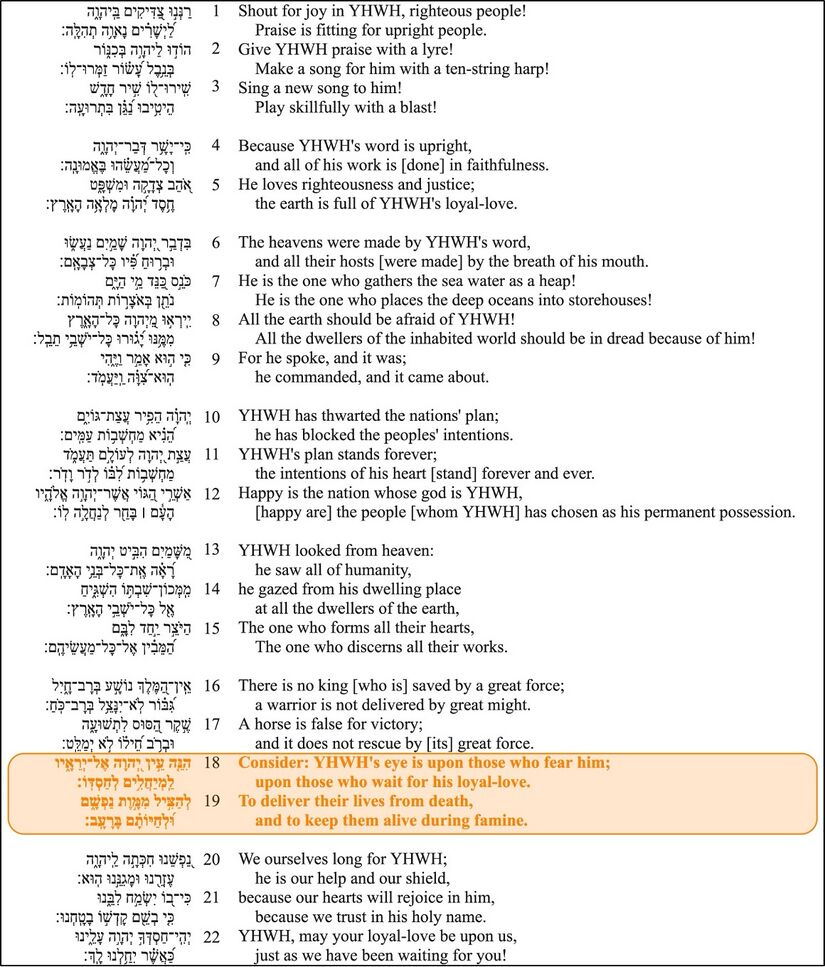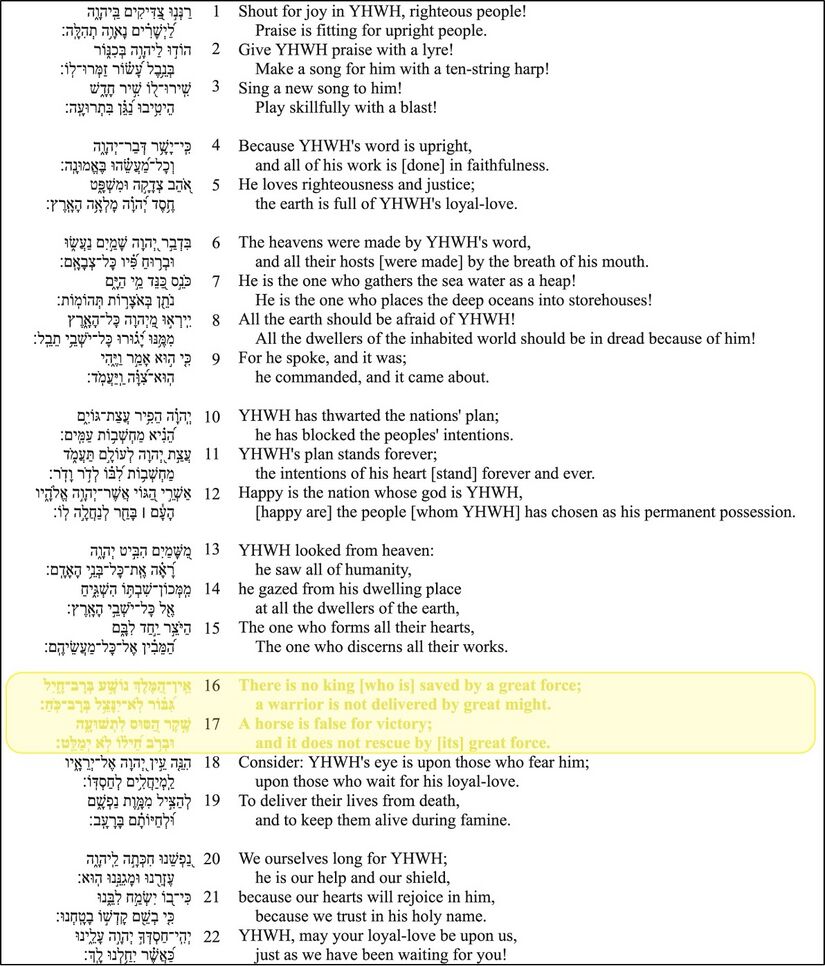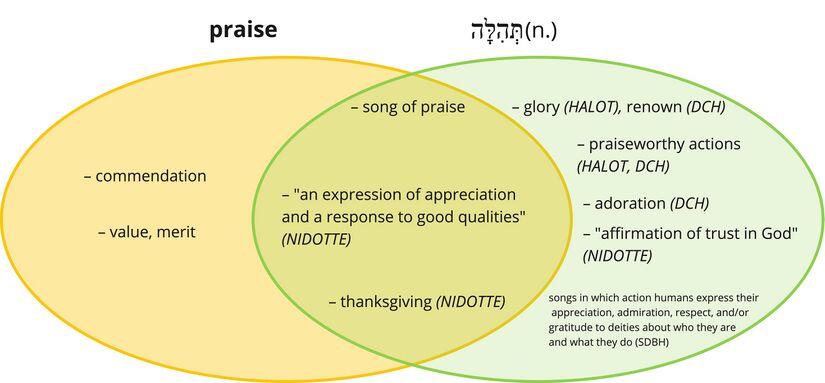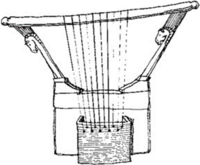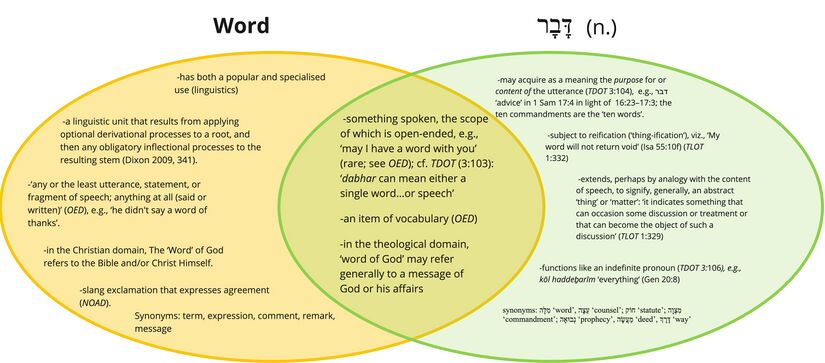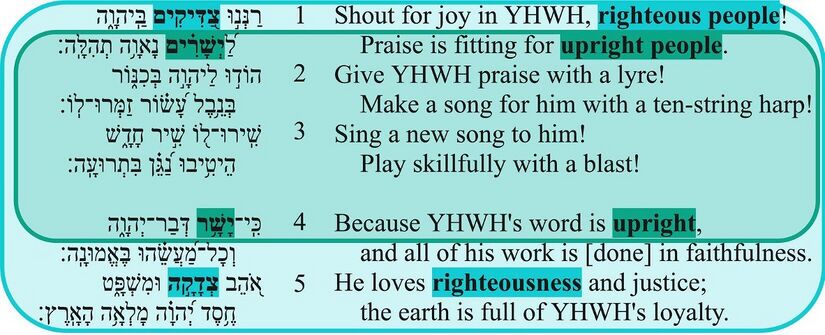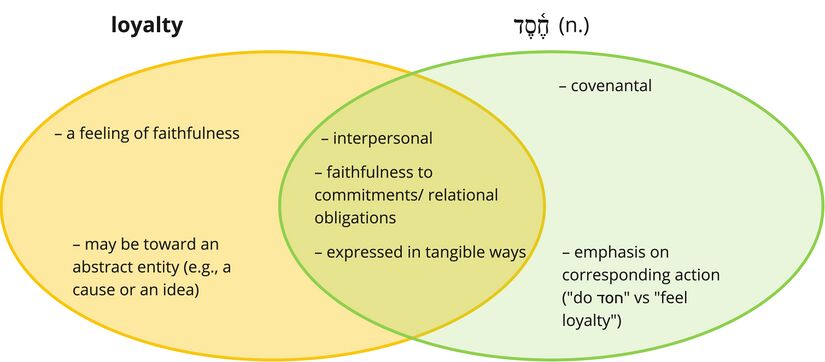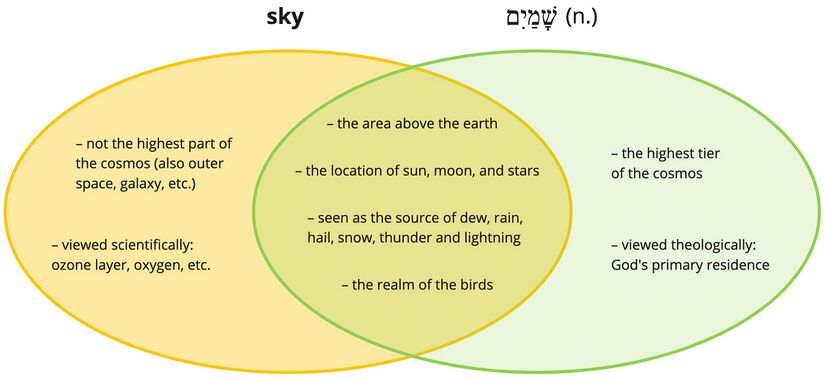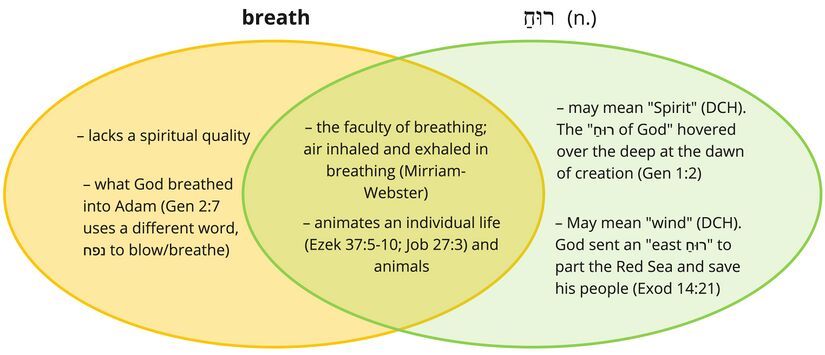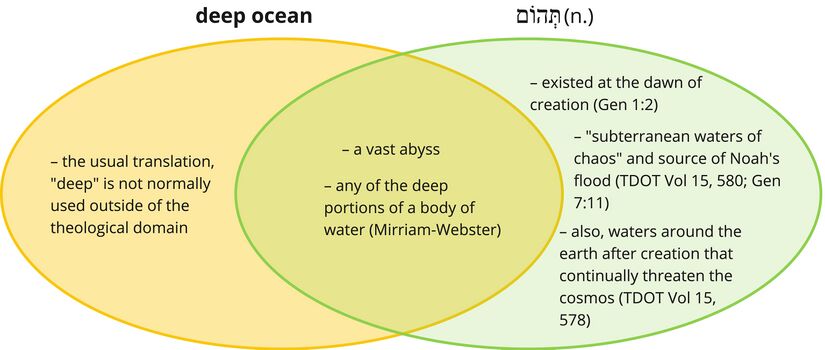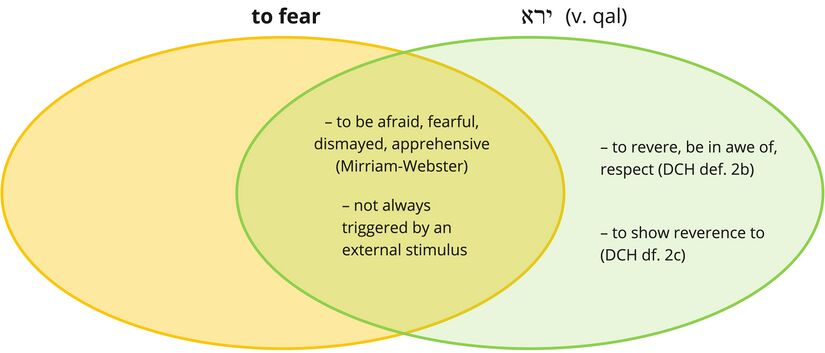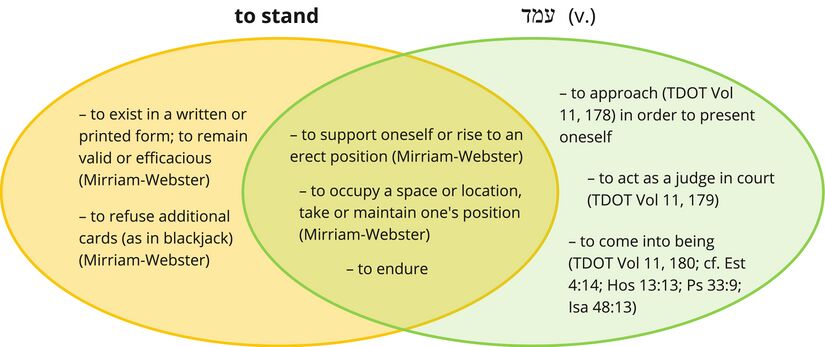Psalm 33 Translation
Jump to: Overview Verse-by-Verse
General Translation Tips
To translate poetry accurately and beautifully, a knowledge of both the source language's poetry and the target language's poetry is needed. So, here are the steps we recommend to follow when setting out to translate this or any psalm:
- Gain an Understanding of the Target Language’s Poetry/Arts. Research and analyze many examples from numerous genres of poetry, storytelling, and music in the target language and culture, and document findings. See our Local Arts Analysis Guide for help.
- Gain an Understanding of the Source Language’s (Hebrew) Meaning and Poetry. The aim of all our materials is to provide exactly this for the translator, poet/musician/artist, and consultant: an understanding of what the psalm means, as well as its poetics.
- Translate the Psalm in the Appropriate Local Art/Poetry Genre(s).
- Test the Translation with the Language Community. Seek feedback about both word choices and the form/genre/media of translation.
Overview: Psalm 33 as a Whole
These are the elements that we believe are most helpful to keep in mind during both drafting and checking translations, to help verify that the translation or performance is accurate beyond just a word- or verse-level; just as important is accuracy on the level of a whole. Additionally, these are elements that will guide decisions about performance in oral translations, songs, poems, or other kinds of art based on this psalm.
The following gives a gives a basic Overview of the Psalm, answering the following questions:
- Title-What title best describes this unique psalm?
- YHWH's Plan Stands Forever
- Purpose–Why was this psalm written?
- To inspire YHWH's people to worship while trusting in his loyal plan.
- Content–In summary, what is said in this psalm?
- We remember what YHWH has done in the past. That's why we praise YHWH, and that's why we wait for him to do the same again.
- Message–What is the general theme of this psalm? What seems to be the main point the psalmist wanted his audience to realize by hearing this psalm?
- Don't give up on God! Praise him as we wait on his plan!
Every psalm has a coherent story behind it. However, many psalms are not written in typical "story" format, with a clear beginning, middle, and end. Here, we attempt to understand the story and background that prompted the psalmist to write.
- Story Behind-How do the various parts of the psalm fit together into a single, coherent story? What is the main message/theme conveyed by this "story behind"?
- Difficulty arises for YHWH's people, and they long for him and wait for him. That's why YHWH's righteous people gather and worship him in song through the singing of this psalm. As they do so, they remember his acts in creation in history. These acts include his past deliverances, in which the nations threatened YHWH's people, but YHWH prevented the nations' plan.
- Sometime after the psalm is sung, YHWH judges humanity. He delivers his people from their enemies and sustains his people in the face of natural disaster. So, YHWH's people rejoice in him.
- Background Situation-what are the series of events leading up to the time in which the psalm was written?

Knowing the layout of the psalm by sections helps us to understand the progression of thought as the poem progresses.
How to read the visual below: The picture below shows the main “chunks” or pieces of the poem. Verse numbers appear on the left. The second column has a title for each section. The large third column contains a brief summary of the section’s content. As you read through the content column, you will see important words and ideas highlighted in similar colors. The icons on the right may be used as memory aids.
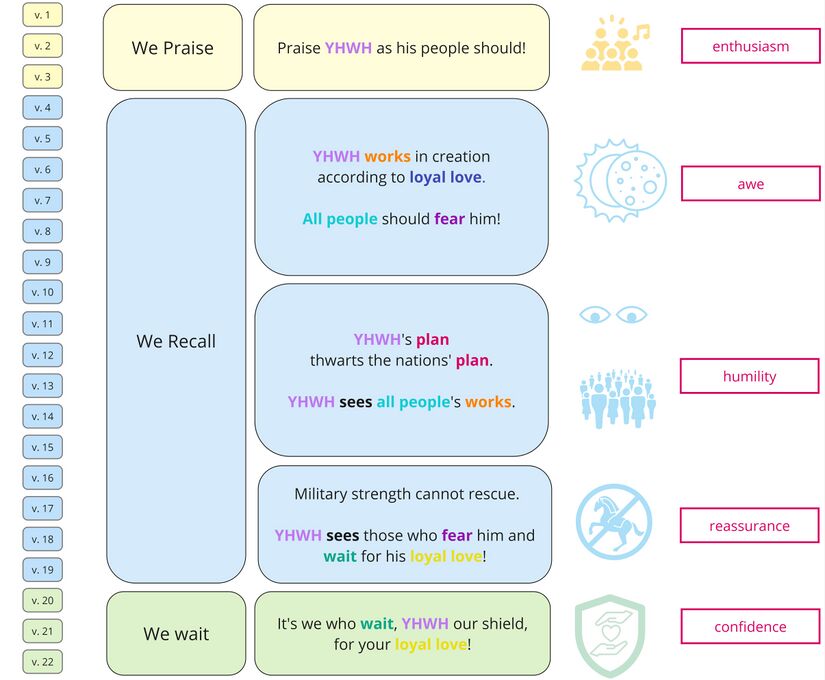
Progression of Thought-How do the sections of the psalm flow from one to the other?
- The progression of the psalm moves through three sections:
- The opening three verses call YHWH's people to make joyful praise.
- Then the long middle section explains why to praise. The middle section starts with a summary statement that YHWH's works are good and they fill the world. The middle section then gives three examples of YHWH's good works in the world. The examples are: 1) YHWH has powerfully ordered creation, 2) YHWH has stopped other nations, so his nation is happy, and 3) YHWH has seen all people, so he discerns their works. The middle section continues with a reminder that armies and horses cannot save, but YHWH watches to save those who fear and wait for him.
- In the final three verses, the people declare that they are the ones who wait for and trust in YHWH. So, they ask YHWH to apply his loyal love to them.
Part of poetry is communicating emotion. Each section, and even each verse, can contain a number of different emotions. Here are the main emotional themes of each section:
In poetry, it is important to keep track of who is speaking, who is the audience, and what it is that the speaker is trying to do with his words.
In the chart below, the left-hand column identifies the speaker. For the first 19 verses of this psalm, the speaker is the choir director, and in verses 20-22 the choir director and the people join together to speak.
The right-hand column identifies the audience, which is Israel - except for the last verse of the psalm, where the audience is YHWH.
The middle column tells what the speaker is trying to do with his words (his speech acts) in each section. An exhortation like the one in verses 1-3 actively urges someone to do something: in this case, praise! A petition like the one in verses 20-22 is a request: in this case, the people request that YHWH will apply his loyal love to them.
In this section, we ask, "what kinds of artistic beauty did the psalmist incorporate into the poem to reinforce its message?" (See Poetic Features video and layer for more details.)
Feature 1: Absence of YHWH
YHWH appears as a participant in every verse of this psalm except verses 16-17.[1] YHWH's absence in these verses makes them stand out within the psalm. After exclusively positive verses about YHWH for the whole psalm, there is an emotional shift in verses 16-17. There is nothing positive in verses 16-17, which only discuss false hopes for victory (kings, warriors, and horses).
The absence of YHWH creates a kind of poetic pause here. Then, immediately following verses 16-17, the psalmist calls the audience to attention with the discourse particle "Consider" (הִנֵּה) in verse 18a. This call to consider that YHWH is paying attention may suggest that people were tempted to do the opposite: to trust in military strength, to doubt YHWH’s attentiveness, and to seek alternative means of rescue. Without directly accusing anybody of such a thought, the poetry of verses 16-19 argues both against all human means for victory and for strict dependence on YHWH alone.
Feature 2: The Unexpected Enemies
YHWH’s name occurs 6 times in verses 1-9 and 6 times in verses 11-22. Six occurrences, in Hebrew poetry, is distinctively “imperfect,” meaning that both sections need the occurrence of YHWH in verse 10a in order to achieve a perfect seven occurrences of the divine name. Thus, verse 10a structurally binds the psalm together in the middle.
Strikingly, verse 10a presents a state of affairs to the psalm that is unexpected and new. There are no overt clues in the first 9 verses of the psalm that the nations are a concern, that they have a plan, or that YHWH has thwarted their plan. As so many times in the Psalms, enemies did not need to be explicitly mentioned in order to be present. But YHWH's people did not need to fear these enemies, because YHWH would always thwart them. The discussion of YHWH’s power over creation (verses 4-9) establishes his equal power over enemies and their plans (verses 10-15).
Additionally, the name YHWH is fronted at the very beginning of verse 10a, and this is the only time this happens within the psalm, despite YHWH's name appearing 13 times. The result is a stress upon YHWH: "(It was YHWH who) thwarted the nations' plan." This is not simply a hymn in praise of YHWH. It reassures those singing that YHWH always has (and always will) thwart enemy plans. That is what gives them cause to rejoice even while they long and wait for him.
Feature 3: YHWH's nation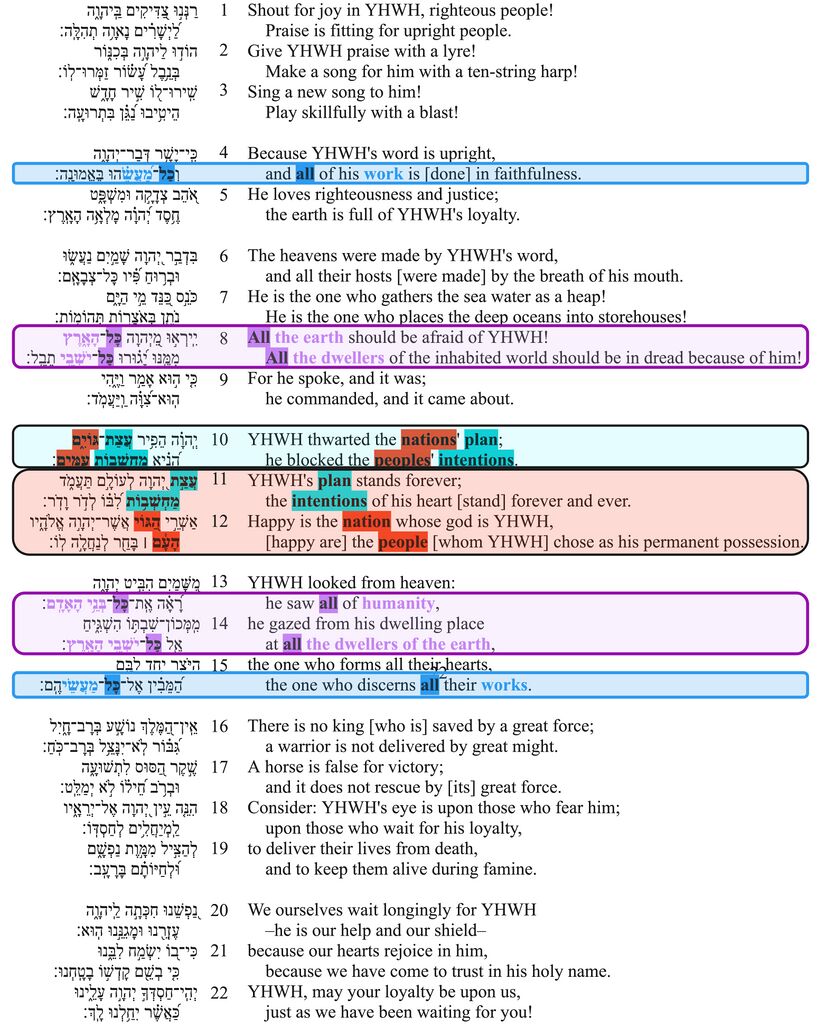
At the center point of Psalm 33, the psalmist uses word play to contrast the nations of the earth and the LORD and his nation. Verse 10 speaks of the nations' plan and intentions, which are contrasted with YHWH's plan and intentions in the next verse (verse 11). Verse 10 also refers specifically to the the nations (גוים) and peoples (עמים), which are contrasted with Israel, YHWH's nation (הגוי) and people (העם) in verse 12.
The word play in these central verses present a reversal, where the nations' plan and intentions do not last, but are thwarted. The central location of this feature within the psalm reflects the central message of the psalm to trust in YHWH's plan instead of military strength.
It is also important to consider how the author chose to draw attention to certain parts of the psalm. Here are the parts of the psalm that we believe are most prominent, and thus should be most prominent in a performance of the psalm.
The most prominent part of Psalm 33 is verses 10-12:
- These verses contrast the plan and intentions of the nations with the plan and intentions of YHWH.
- The nations plan to destroy the people of God, but YHWH thwarts the plan of the nations.
- YHWH's plan is to rescue his people, and his plan stands forever.
- Therefore, YHWH's people are happy.
The second-most prominent part of the psalm is verses 18-19:
- Verses 18-19 tie together many important themes from earlier in the psalm: YHWH's loyal-love (from verse 5), fearing YHWH (from verse 8), and YHWH's looking (from verses 13-15).
- Verses 18-19 turn these themes into a promise that the audience applies to themselves in the final section (verses 20-23). YHWH looks at those who fear him, so that YHWH will apply his loyal love to them.
The third-most prominent part of the psalm is verses 16-17.
- Every verse in the psalm features YHWH as a participant, except verses 16-17.
- Instead of YHWH, the main participants of these verses are agents of war such as a king, a warrior, and a horse.
- The emotional effect of these verses is to create a void, or an emotional let-down, after verses 4-15 have given many positive examples of YHWH's character and activity. This sets up the audience to "Consider" the promise of verses 18-19.
Verse-by-Verse Notes (Translation)
View Text
Contents
Verses 1-3: We Sing (with a Blast)!
- Verses 1-3 are a call to praise. These verses are characterized by plural imperatives, meaning that the speaker addresses an entire group. Some languages will need to provide the plural pronoun you to make the audience of the imperative clear. Furthermore, the sense of the imperatives here is that they form an invitation (that is, telling people to do something that they likely want to do) more than a command (that is, telling people to do something that they might not want to do).
- The main emotion in this section is enthusiasm! The emotions are happy as the people are called to sing and make a new song with a blast.
v. 1
| 1.1 | רַנְּנ֣וּ צַ֭דִּיקִים בַּֽיהוָ֑ה
|
Shout for joy in YHWH, righteous people!
|
| 1.2 | לַ֝יְשָׁרִ֗ים נָאוָ֥ה תְהִלָּֽה׃
|
Praise is fitting for upright people.
|
Expanded Paraphrase The words in <i>italics</i> provide a fuller sense of the psalm; the text itself is in <b>bold</b>.
Notes
- Shout for joy is a single word in Hebrew (רנן) that is important to the emotional exegesis of the psalm. Joy is part of the meaning of the Hebrew word and should be included in translation. The NIV translates the verb as sing joyfully and the NLT has sing for joy, but the word is closer to shout for joy (ESV, NET).
- The root for righteous (צַדִּיק) refers to "a pattern of behavior by humans or deities that is in accordance with the requirements of the divine law."[2] It is a key term in this psalm. Here the adjective functions as a noun (that is, substantivally), referring to righteous people. 'Righteous people' (צַ֭דִּיקִים) are the ones to whom the speaker is addressing his statement (using the vocative). Thus, some languages will need to provide you (plural) to make it clear that it is the 'righteous people' who are being addressed (see NIV).
- The prepositional phrase in YHWH (בַּֽיהוָ֑ה) is a figure of speech that means the people are to shout for joy because of YHWH. Translators should attempt to make it clear that YHWH is the reason for the praise.
- The word YHWH is the proper name for Israel's deity; it is not as generic as the term god. The term is important in terms of placement and the number of appearances of the word in the psalm. See the section on Prominence and the notes on verses 10-12 and 16 for more detail.
- The root of the Hebrew word upright is repeated in this psalm; it also appears in verse 5. Here it is an adjective (functioning as a noun) meaning upright people, that is, people "whose behavior is morally and ethically right."[3] 'Upright people' (לַ֝יְשָׁרִ֗ים) is a synonym for the righteous people who have just been mentioned in the previous clause. Languages that do not have words for each term may use the same word for both. The adjectives righteous (צַדִּיק) and upright (יָשָׁר) occur together frequently in the Bible. Try to retain the same renderings for these words as they are found elsewhere.
- The phrase here rendered fitting for (נָאוֶהלַ֝) is a figure of speech that means that the act of praising matches well with people who are upright. Praise is fitting for upright people does not mean that upright people should receive praise, but rather that they should give it, as they are called to do throughout verses 1-3. Some strategies for making this clear include rendering the praise as a verbal idea, such as it is fitting for the upright to praise him (NIV), or making the source of the praise clear, such as praise from the upright is beautiful (CSB).
- Unlike the surrounding phrases, which are all direct commands (with imperative verbs), this phrase is a declaration that functions as an indirect exhortation, that is, an indirect way to encourage a certain kind of behavior. The people are meant to identify themselves as upright people and to respond with the appropriate behavior for such people (specifically, by praising YHWH).
- The English word praise is very close to the Hebrew term (תְּהִלָּה). See the diagram below for a more detailed look at the Hebrew understanding of the root word (green circle on the right), our modern English understanding of the idea (yellow circle on the left), and what the two understandings have in common (the middle section where the two circles intersect):
v. 2
| 2.1 | הוֹד֣וּ לַיהוָ֣ה בְּכִנּ֑וֹר
|
Give YHWH praise with a lyre!
|
| 2.2 | בְּנֵ֥בֶל עָ֝שׂ֗וֹר זַמְּרוּ־לֽוֹ׃
|
Make a song for him with a ten-string harp!
|
Expanded Paraphrase The words in <i>italics</i> provide a fuller sense of the psalm; the text itself is in <b>bold</b>.
Notes
- The words for the instruments in this verse could be challenging:
- The lyre (kinnor, כִנֹּור; for a video of a lyre in use click here) is "a musical instrument consisting of a sound box made of wood, out the ends or sides of which projected two arms; the arms supported by a crosspiece; strings descended from the crosspiece over the sound box and the number of strings could vary."[4] This is the instrument that David played, and is traditionally rendered in English as harp. So, translators should use the same term here as in 1 Sam 16:15, 23, where David plays a kinnor.
- The wordharp (nebel, נֵ֫בֶל) is uncertain. Some propose that it was a soundbox made of wood with animal intestines stretched over the top.[5] In Ps 32:2 the word ten refers to the number of strings.
- It may not be possible to find exact matches in the local culture for these instruments, but translators can keep a few guidelines in mind.
- Stringed instruments should be preferred, if they are available in the local culture, but any instrument used in celebration may be used.
- The kinnor was more common than the nebel.[6] So, if possible, translators may choose a more common instrument in the local culture to translate the first word, and a rarer instrument to translate the second.
- If more than one instrument is not available, then translators may simply repeat the same instrument.
- The combination of lyre (כִנּ֑וֹר) and harp (נֵ֫בֶל) was common in worship. For example, they appear together in Ps 150:3-5 and 1 Chr 16 and 25:1-8. Translators should strive to match the translation of these words in Ps 33 with those passages.
- The prepositional phrases with a lyre and with a harp mean by playing a lyre/harp. Some languages may require making clear that these are instruments being played, and that the playing is what brings about the praise: “praise the Lord by playing music on the lyre.”[7]
- In Hebrew, the phrase with a ten-stringed harp is out of the typical word order. It is fronted within its clause. The result is that the whole verse is poetically arranged (in a tail-head linkage) so that the center emphasizes both of the phrases about instruments. It looks like this:
v. 3
| 3.1 | שִֽׁירוּ־ל֭וֹ שִׁ֣יר חָדָ֑שׁ
|
Sing a new song to him!
|
| 3.2 | הֵיטִ֥יבוּ נַ֝גֵּ֗ן בִּתְרוּעָֽה׃
|
Play skillfully with a blast!
|
Expanded Paraphrase The words in <i>italics</i> provide a fuller sense of the psalm; the text itself is in <b>bold</b>.
Notes
- The phrase a new song (שִׁיר חָדָשׁ) is a common phrase found "in calls to praise with renewed enthusiasm resulting from a new experience of deliverance or a new appreciation of the Lord's presence."[8]שִׁ֣יר חָדָ֑שׁ) could be sung in anticipation of the "new things" that YHWH was about to do for his people (Isa 42:9-10), in response to being rescued from the pit (Ps 40:2-3), so that all the earth would know the greatness of YHWH and that his judgment is coming soon (Pss 96), as a response to YHWH's saving act in battle (Ps 98), or as a battle cry before the people execute judgment on the nations with swords (Ps 149). For a detailed discussion of the usage of new song in Psalm 98, see the Exegetical Issue "What Prompts the “New Song” of Psalm 98:1?" The call "to sing a new song was a way of calling people to enjoy God's presence and his benefits, so that they would have something new to sing about in the sanctuary."[9] So, what is in focus is not the content of the new composition, but the feeling that caused the new composition to be sung.
- The pronoun him refers to YHWH.
- Some languages cannot use the verb play without naming the instrument; in this case, translators should supply the lyre (and possibly the harp) or a generic term like instruments.
- Words that communicate playing well or beautifully could replace skillfully here. The word skillfully means to do well.
- The meaning of the challenging word blast (תְרוּעָֽה) indicates that its most important feature is not who or what is making the sound, but how loud the sound is.[10] So the common English translation shout may not be the best choice. The focus on instruments in verses 1-3 suggest that it is the instruments making the loud sound - so, loud sound is another translation possibility. The heightened volume expresses joy, and it often occurs in warfare as a call to arms.[11] The Hebrew word does not necessarily connote that the sound is sudden, though, as the English word 'blast' might.
Verses 4-19: We Recall (YHWH is powerful)
- The middle section (verses 4-19) provides the reasons for the praise in the first section (verses 1-3) "by elaborating certain representative acts of God in creation and history."[12]
- The verse lines in verses 4–19 appear in pairs that display parallelism.
Verses 4-5: Summary of Reasons
- Verses 4-5 contain a summary statement of YHWH's character and work.
- These verses contain a parallelism of adherence to a standard and adherence to a relationship:
- adherence to a standard appears as uprightness (verse 4a) and justice (verse 5a)
- adherence to a relationship appears as faithfulness (verse 4b) and loyal love (verse 5b).[13]
v. 4
| 4.1 | כִּֽי־יָשָׁ֥ר דְּבַר־יְהוָ֑ה
|
Because YHWH’s word is upright,
|
| 4.2 | וְכָל־מַ֝עֲשֵׂ֗הוּ בֶּאֱמוּנָֽה׃
|
and all of his work is [done] in faithfulness.
|
Expanded Paraphrase The words in <i>italics</i> provide a fuller sense of the psalm; the text itself is in <b>bold</b>.
Notes
- The wordBecause (כִּֽי) that begins verse 4 is a crucial conjunction in this psalm that should not be missed by translators. It connects verses 1-3 with verses 4-19, which give the reasons why the congregation should praise YHWH. Though most English translations render this word as for, the word for is not the normal way to introduce reasons in modern English.
- The root of the word upright (יָשָׁר) is repeated in this psalm. It described the audience in verse 1b, and here it describes YHWH's word. Thus, the psalmist describes the audience in terms of YHWH's good character. Translators should retain the repetition.
- The phrase YHWH’s word is repeated in this psalm; it also appears in verse 6. Translators may render it as the words that YHWH speaks. These words include both instructions and the power to create, as verse 6 indicates. See the Venn diagram below for a more detailed look at the Hebrew understanding of the term word (green circle on the right), our modern English understanding of the idea (yellow circle on the left), and what the two understandings have in common (the middle section where the two circles intersect):
- The key word work shares a root with the verb to do (עָשָׂה), which in verse 6 describes YHWH's act of creating the heavens. Thus, the creation of the heavens is an example of YHWH's faithful work. In many languages, it will be necessary to convert the word 'work' into a verb, with the resulting phrase all he does (NIV; NLT: everything he does).
- The word faithfulness (אֱמוּנָֽה) describes "a state in which humans and deities are considered worthy of trust, because they are truthful and committed, with an unwavering disposition, which is reflected in their actions."[14] When applied to God, it expresses "his total dependability."[15] Although in this verse it is YHWH's works and not himself that is in view, his works take on his character. In some languages it will be necessary to change 'in faithfulness' to a verbal phrase, such as the NLT's we can trust or the NIV's he is faithful in.
v. 5
| 5.1 | אֹ֭הֵב צְדָקָ֣ה וּמִשְׁפָּ֑ט
|
He loves righteousness and justice;
|
| 5.2 | חֶ֥סֶד יְ֝הוָ֗ה מָלְאָ֥ה הָאָֽרֶץ׃
|
the earth is full of YHWH’s loyal-love.
|
Expanded Paraphrase The words in <i>italics</i> provide a fuller sense of the psalm; the text itself is in <b>bold</b>.
Notes
- The noun righteousness (צְדָקָ֣ה) is a key term that shares the same root as the word righteous people (צַ֭דִּיקִים) in verse 1. Thus, the audience is addressed by the psalmist as those whose character YHWH loves. Translators should repeat the sense of the root in both verses or use similar-sounding words. This root and the word upright both describe YHWH's people (verse 1) and what YHWH loves (verses 4-5). They appear in a mirror ab//ba pattern in the section. It looks like this:
- The combination of righteousness (צְדָקָה) and justice (מִשְׁפָּט) can be performed either by YHWH or by his people. In this verse, YHWH's love of these activities results in the earth being full of his loyal love (verse 5b), which suggests that YHWH is the one doing righteousness and justice: YHWH loves to do righteousness and justice, therefore the earth is full of his loyal love. For languages that need a verbal translation of these abstract nouns, a rendering like YWHH loves to do what is right and to judge fairly is possible.[16]
- The Hebrew root of the word righteousness (צדק) "focuses on the principle of 'what is right, correct.'" In contrast, justice (מִשְׁפָּ֑ט) "often refers to the practical consequences of righteousness" in society.[17] Translators should attempt to distinguish the terms if possible, but some languages may lack separate words for these concepts. In this case, it is best to use a single word with intensification, such as: YHWH loves to do what is thoroughly just. The word combination occurs often in the OT.
- The verb is full (מָלְאָ֥ה) is stative in Hebrew. It "represents a state flowing from an earlier situation."[18] Many English translations, such as the NLT, render the verb in its active sense (YHWH's loyal love fills the earth) but an active rendering should be avoided unless it is the only choice in the target language.[19]
- The term loyal love is a key term. It is a single word in Hebrew (חֶסֶד) that includes a number of concepts that are difficult to translate into one English word. It refers to loyalty, faithfulness, kindness, love, and mercy,[20] and the fulfilling of obligations.[21] The two most essential of these are loyalty and love, or loyal love. The word also occurs in verses 18 and 22, and should be translated consistently throughout the psalm. See the Venn diagrams below for a more detailed look at the Hebrew understanding of the root word (green circle on the right), our modern English understanding of the ideas of "loyalty" and "love" (yellow circle on the left), and what the two understandings have in common (the middle section where the two circles intersect):
- The CEV renders the figure of speech the earth is full of YHWH’s loyal love as he is kind to everyone, but doing so equates the earth with people. This adds interpretation to the text that may not be there in the Hebrew. Although the word the earth can mean all people on earth (as it does in verse 8), here in verse 5 it probably means the created, physical world mentioned in verses 6-7. For languages in which the expression the earth is full ofwould not work, an alternative would be everything in the earth has received the Lord’s loyal love.[22]
- The dominant emotion in this section of the psalm is awe, as the psalmist speaks of the power that YHWH has to control creation.
Verses 6-9: YHWH Controls Creation
- Verses 6-9 contain the language of creation: the heavens (verse 6a), the sea waters and deep oceans (verse 7), and the earth (verse 8), as well as the phrase he spoke and it was, which is a reference to the creation story in Gen 1.
- The Israelites viewed creation with great oceans surrounding the earth and sky. The sun, moon, and stars inhabited the heavens. Above the heavens was a firmament (or wall) that usually prevented the upper seas above from pouring down rain on the earth. Below the earth were the great deep oceans, which sprung up in wells and springs.
v. 6
| 6.1 | בִּדְבַ֣ר יְ֭הוָה שָׁמַ֣יִם נַעֲשׂ֑וּ
|
The heavens were made by YHWH’s word,
|
| 6.2 | וּבְר֥וּחַ פִּ֝֗יו כָּל־צְבָאָֽם׃
|
and all their hosts [were made] by the breath of his mouth.
|
Expanded Paraphrase The words in <i>italics</i> provide a fuller sense of the psalm; the text itself is in <b>bold</b>.
Notes
- The original order of the words in the first line of this verse is By YHWH's word the heavens were made (as in ESV, NASB, NIV, NET, NRSV). We have rearranged the order to create a more smooth English translation, but the original order should be retained in the target language if doing so does not create difficulty in understanding.
- The wordheavens (שָׁמַיִם) has different meanings in Hebrew and modern English, and translators should seek to be faithful to the Hebrew. The Venn diagram below shows the Hebrew understanding of the word (green circle on the right), our modern English understanding of sky (yellow circle on the left), and what the two understandings have in common (the middle section where the two circles intersect):
- The phrase were made by consists of a passive verb (נַעֲשׂ֑וּ) and the preposition by (בִּ) that marks the means (that is, the instrument) used to create the heavens.[23] Some languages may require an active verb instead of a passive verb. In this case, a translation like By his word the Lord made the heavens (TOB translated) still treats YHWH’s word as the instrument and not the subject of the verb, which is closer to the Hebrew than the REB's The word of the Lord created the heavens (REB).
- The phrase the breath of his mouth (ר֥וּחַ פִּ֝֗יו) is a figure of speech that applies the language of a human body part, a mouth, and a human function, breath, to YHWH. It may be helpful to bear in mind that here the phrase appears in parallel with YHWH's word.[24] Thus, the breath of his mouth further describes YHWH's spoken, creative word. The complete phrase could be understood as the breath that comes out of his mouth. Commentators are correct that the essential meaning of this phrase is that the Lord commanded, and in the target language the phrase may need to be transformed into something like when the Lord commanded.[25]
- But if there is a clear way to retain the imagery in the local language, this should be done in order to be faithful to the beauty of the poem.
- Although the Hebrew word for breath (ר֥וּחַ) sometimes means spirit elsewhere in the OT, that is not the sense here. The Venn diagram below shows the Hebrew understanding of the word breath (ר֥וּחַ) (green circle on the right), our modern English understanding of breath (yellow circle on the left), and what the two understandings have in common (the middle section where the two circles intersect):
- Hosts (צְבָאָֽ) most literally refers to an army. The phrase all their hosts means all the army of the heavens, which is an image that means the sun, moon, and stars (see also Gen 2:1, which uses the same phrase as here in Ps 33:6). The NLT renders the term hosts as stars, and this may be the best choice in many languages. However, military imagery is a significant part of this psalm (verses 10, 16-17), and translators could follow the NIV's starry host to retain the image while making the meaning clear. Translators should also be careful that their rendering does not refer to spiritual beings, which are not in view here.
- The second clause of verse 6 literally says and all their hosts by the breath of his mouth. It contains no verb; instead, the clause is governed by the verb from the previous clause for economy of style and poetic effect. It is possible that translators will need to repeat the verb were made (נַעֲשׂ֑וּ) in the second clause.
v. 7
| 7.1 | כֹּנֵ֣ס כַּ֭נֵּד מֵ֣י הַיָּ֑ם
|
He is the one who gathers the sea water as a heap!
|
| 7.2 | נֹתֵ֖ן בְּאֹצָר֣וֹת תְּהוֹמֽוֹת׃
|
He is the one who places the deep oceans into storehouses!
|
Expanded Paraphrase The words in <i>italics</i> provide a fuller sense of the psalm; the text itself is in <b>bold</b>.
Notes
- The phrases he is the one who gathers and he is the one who places are both single words in Hebrew (participles). They could be rendered as verbal, as the NIV does: he gathers/he puts. But the preferred reading is to take both of these participles as nouns (substantival). They describe well-known characteristics of YHWH: he is the one who...[26]
- The phrase gathers the sea waters as a heap is an image that refers to YHWH's power over creation. But the specific wording 'as a heap' is a clear reference to the crossing of the Red Sea and the crossing of the Jordan. In both of these events, God miraculously gathered 'the sea waters as a heap.' Translators should attempt to use the same wording here as in those passages (Exod 15:8, Josh 3:13, 16; Ps 78:13).
- The phrase the sea waters is literally the waters of the sea (it is a construct chain). It refers to not just any water, but the water of the sea, thus signifying YHWH's power over vast amounts of water. The sea waters do not refer to the waters above the skies, which are never referred to as the sea. See the creation visual under the Section Notes for verses 6-9 (p. 15) for more detail.
- The phrase as a heap is technically a comparison, but it is possible to render it with the preposition into instead of like/as without losing the meaning. This is the strategy of the CSB (into a heap), the GNT (into one place) and the French NBS and NVSR (en une masse).
- The NLT's rendering He assigned the sea its boundaries is not very close to the Hebrew. Some scholars have argued that the phrase as a heap should be rendered into jars, as the NIV does. But the wording 'as a heap' has good textual support and should be followed.[27]
- The phrase places the deep oceans into storehouses is also an image that refers to YHWH's power over creation.[28] It may contain echoes of the Flood story.[29] The deep oceans burst forth to cause Noah's flood (Gen 7:11) until God shut them up again (Gen 8:2), which is similar to him placing the deep oceans into storehouses.
- The termdeep oceans (תְּהוֹם) may be unfamiliar in many cultures. It refers to the body of water below the earth; the NIV's deep and the NLT's oceans by themselves do not accurately describe it, but combining the two words into 'deep oceans' does. For many cultures, the best way to express the term may be the source of underground springs and well-water, or more vaguely (and poetically) the water under the earth. Here is a Venn diagram comparing the English and Hebrew words:
- The termstorehouses (אוֹצָר) is an image that recurs throughout the OT. Most literally it is a place where "one stores valuable goods" for safekeeping.[30] An example of a specific kind of storehouse might be a room for storing grain. The importance of the storehouses image throughout the OT means that translators should try to retain it here in Ps 33:7, and to translate it consistently throughout the OT (see the footnotes to this paragraph for some of the most important occurrences).[31]
- Some cultures may lack the concept of a storehouse. In that case, the important point is that it is a place where things can be shut inside. So, possible alternatives might be inside closed spaces or inside closed rooms.
- The termstorehouses (אוֹצָר) is an image that recurs throughout the OT. Most literally it is a place where "one stores valuable goods" for safekeeping.[30] An example of a specific kind of storehouse might be a room for storing grain. The importance of the storehouses image throughout the OT means that translators should try to retain it here in Ps 33:7, and to translate it consistently throughout the OT (see the footnotes to this paragraph for some of the most important occurrences).[31]
v. 8
| 8.1 | יִֽירְא֣וּ מֵ֭יְהוָה כָּל־הָאָ֑רֶץ
|
All the earth should be afraid of YHWH!
|
| 8.2 | מִמֶּ֥נּוּ יָ֝ג֗וּרוּ כָּל־יֹשְׁבֵ֥י תֵבֵֽל׃
|
All the dwellers of the inhabited world should be in dread because of him!
|
Expanded Paraphrase The words in <i>italics</i> provide a fuller sense of the psalm; the text itself is in <b>bold</b>.
Notes
- The phrase all the earth is a figure of speech which refers to everything in creation (that is, animals, rocks, trees, etc.) including Israel and other nations, that is, all the people who live on the earth. The parallel line all the dwellers of the inhabited world narrows the scope to people.
- The participants are important in this verse. It is unlikely that the speaker of verse 8 is talking to all the earth and all the dwellers of the inhabited world directly; other nations would have been unlikely to accept that they should fear YHWH's power as it is described in verses 4-9. The statements of verse 8 instead make sense as rhetorically-charged statements to Israel about the power and supremacy of YHWH: everyone should fear YHWH, so certainly Israel should fear YHWH!
- Both of the verbs rendered should be afraid (יִֽירְא֣וּ) and should be in dread (יָ֝ג֗וּרוּ) express what ought to happen (they are jussives). Most modern translations render them as Let...fear…let…revere. The problem with this rendering in English is that it sounds like the psalmist is granting permission rather than expressing how things ought to be. Translators should attempt to render these verbs with a similar sense to 'should' in their languages.
- To fear (be afraid of) God is to be in awe and reverence of him (Mal 2:5) and to trust him (Ps 40:3; 115:11).[32] See the Venn diagram below for a more detailed look at the Hebrew understanding of the word be afraid of (ירא) (green circle on the right), our modern English understanding of 'to fear' (yellow circle on the left), and what the two understandings have in common (the middle section where the two circles intersect):
- Most English translations render the word dwellers (יֹשְׁבֵי) as inhabitants or people. Here we have chosen to render it as 'dwellers' in order to highlight the connection with verse 14, where YHWH gazes upon the dwellers of the earth from his dwelling place (all of the dwelling words share the same Hebrew root). Translators should attempt to use the same word here and in verse 14 to enhance the sense of unity throughout the poem. In some languages, the term dwellers may take a verbal function: the people dwelling.
- The inhabited world (תֵבֵֽל) is a single Hebrew word whose specific sense often cannot be translated into another language with just one word. It means "the earth as opposed to the sky, with special focus on the area that is inhabited by humans."[33] If there is not a way in the local culture to convey this meaning, then translators could use a synonym for the earth such as the world.
- The word be in dread (גור) is "an even stronger" version of be afraid of which "means to be intimidated by something [or someone] superior and more powerful."[34] The ancient translations be shaken (LXX) and be disturbed/shake/tremble (Peshitta) suggest that this was an emotion of fear that had a physical effect. Most modern translations, with their renderings of stand in awe,[35] revere,[36] and honor,[37] undersell the powerful effects of the verb upon a person.[38] With the combination of the words be afraid of and be in dread, the verse covers a range of emotion from awe/reverence to panic/terror.
v. 9
| 9.1 | כִּ֤י ה֣וּא אָמַ֣ר
|
For he spoke,
|
| 9.2 | וַיֶּ֑הִי
|
and it was;
|
| 9.3 | הֽוּא־צִ֝וָּ֗ה
|
he commanded,
|
| 9.4 | וַֽיַּעֲמֹֽד׃
|
and it came about.
|
Expanded Paraphrase The words in <i>italics</i> provide a fuller sense of the psalm; the text itself is in <b>bold</b>.
Notes
- The first word for/because/since (כִּי) is a crucial conjunction that indicates the reason for the ideas in the immediately preceding section of verses 6-8.[39] It is not just "an extra syllable whose function is to add an extra beat to the line."[40]
- In both lines of this verse, the word he (ה֣וּא) appears in a non-typical place (both subject-pronouns come before finite verbs, which is unusual in Hebrew). This structure emphasizes that YHWH is the one who spoke and commanded, and no one else. So, translators may render these phrases as something like for it is he who spoke, and it was and it is he who commanded, and it came about. Even if this particular rendering is not feasible in the target language, translators should still consider somehow drawing emphasis to the two he pronouns.
- The phrase he spoke, and it was is a clear reference to Genesis 1. This knowledge helps translators to fill in some informational gaps:
- The verb spoke begs the question, "what was said?" Genesis 1 tells us that God said, "Let there be…" in order to create. Psalm 33 elsewhere refers to this as YHWH's word (verse 6). For languages that require a direct object for the verb 'spoke,' then, translators may say he spoke his word.
- The referent of the word it is not clearly stated. It could be rendered to mean what God said (based upon the context of the verse) or even creation (based on the clear connection to Genesis 1).
- The verb was means came into existence or began to exist (this is the inchoate sense).[41] Several English translations do a good job making this sense clear with the renderings it came to be (ESV, NIV, NRSV) or it came into being (CSB).
- Unlike the first phrase, the second phrase he commanded, and it came about does not contain vocabulary from Genesis 1. So it probably refers to YHWH's commands to people and to nature to behave in certain ways in history.
- For languages that require a direct object for the verb he commanded, translators should be vague: he commanded events or he commanded his intentions (which would match well with verse 11) are possibilities.
- Again, the referent of the word it is not clearly stated in Hebrew. Here it is what he commanded or the events he commanded.
- The Hebrew word translated and it came about (וַֽיַּעֲמֹֽד) most literally means and it stood. Many English translations render it as endured or stood firm (NIV). We have chosen to render it closer to the sense of arise (the inchoate sense of the verb), which fits the idea of events happening. However, it should be noted that the same verb occurs in verse 11 to say that YHWH's plan stands forever. There, the emphasis is on enduring or standing firm. So translators may choose to render it that way in this verse, too; consistency will add to the sense of unity in the poem. See the Venn diagram below for a more detailed look at the Hebrew understanding of the word (green circle on the right), our modern English understanding of 'to stand' (yellow circle on the left), and what the two understandings have in common (the middle section where the two circles intersect):
- The author of Psalm 33 assumed that the audience could make the above connections without him making all of the information explicit. So, in languages where this information is not necessary for syntax and meaning, translators should consider mimicking the author's poetic economy of style.
Verses 10-12: YHWH's plan, not the nations' plan
- Verses 10-12 are at the center, and are the most prominent part of the psalm. See page 6 for more detail. When putting this psalm to music, consider making these verses a repeated refrain.
- Verses 10-12 are the only part of the psalm that contains the divine name YHWH in every verse.
- The name YHWH occurs six times before verse 10 and six times after verse 10. This numbering means that both halves of the psalm need to include verse 10 in order to achieve a perfect seven occurrences of the divine name. This feature points to verse 10 (and thus verses 10-12) as very prominent in the psalm. In verse 10, YHWH is fronted for emphasis, which is the only time this happens in the psalm and which also contributes to the prominence of the verse.
v. 10
| 10.1 | יְֽהוָ֗ה הֵפִ֥יר עֲצַת־גּוֹיִ֑ם
|
YHWH has thwarted the nations’ plan;
|
| 10.2 | הֵ֝נִ֗יא מַחְשְׁב֥וֹת עַמִּֽים׃
|
he has blocked the peoples’ intentions.
|
Expanded Paraphrase The words in <i>italics</i> provide a fuller sense of the psalm; the text itself is in <b>bold</b>.
Notes
- English translations usually render the verbs has thwarted and has blocked as present tense verbs that connote timelessness (in other words, they happen all the time; for example, thwarts and blocks). However, the Hebrew verb form (qatal) is very unlikely to take on a simple present tense or timeless sense with action verbs like these. Hebrew qatals refer to past events. While the hearer may infer that what YHWH has done in the past, he will do again for us now, the verbs themselves do not have this meaning.[42] These verbs are best translated using an equivalent of the English present perfect tense, as we have done here (he has thwarted…he has blocked). This tense refers to an event that took place in the past, but whose effects are still felt in the present time. If an equivalent of the present perfect is not available in the local language, the next best option is the simple past tense: thwarted and blocked.
- The Hebrew verb translated has thwarted (פור) is related to the verb (פרר) which means "to break, perhaps by bursting from within rather than by smashing from without." The form which is represented here (hiphil) "takes exclusively non-concrete objects" such as a covenant (Ezek 17:19). Other possible renderings might be has sabotaged or, most poetically, has caused to burst apart. Many English translations render this verb as frustrates (NLT, CSB, GNB, NET), but the expression frustrates someone's purposes/counsel/plans is awkward English that does not have the benefit of retaining the imagery of bursting.
- The wordplan (עֵצָה) is a repeated word in this psalm, since the central theme of this psalm is that YHWH's plan triumphs while the nations' plan does not. The word is singular, so that the nations share a single plan against Israel (Psalm 83:2-8).
- The nations in this verse refers to pagan, non-Israelite nations.
- The word rendered intentions (מַחְשְׁבֹ֥ות) has "thought" as its first definition in many Hebrew lexicons, but to characterize this term as expressing mere thought is misleading. It is part of a "procedure for achieving a certain purpose, originating from someone's mind."[43]Before the flood, YHWH saw that "all the purpose of the intentions (מַחְשְׁבֹ֣ת) of the peoples' heart was only evil all the time" (Gen 6:5).
- In some languages, the phrases the nations’ plan and the people's intentionsmay need to be rendered as verbal ideas: what the nations were planning and what the people were intending.
v. 11
| 11.1 | עֲצַ֣ת יְ֭הוָה לְעוֹלָ֣ם תַּעֲמֹ֑ד
|
YHWH’s plan stands forever;
|
| 11.2 | מַחְשְׁב֥וֹת לִ֝בּ֗וֹ לְדֹ֣ר וָדֹֽר׃
|
the intentions of his heart [stand] forever and ever.
|
Expanded Paraphrase The words in <i>italics</i> provide a fuller sense of the psalm; the text itself is in <b>bold</b>.
Notes
- The Hebrew word rendered stands (תַּעֲמֹד; see verse 9) is a poetic image that here means endures, since it is coupled with the word forever. The word 'stands' is the only verb in this verse, and it is implied in the second clause for poetic effect. For clarity, translators may choose to supply the verb again in the second half of the verse.
- The word heart (לֵב) is an image that uses the language of human body parts to describe an aspect of God (like the breath of his mouth in verse 6). In English, the 'heart' (לֵב) is the place of a person's emotions and desires. The Hebrew word, by contrast, is the place where both thoughts/reasoning and emotions originate.[44] Translators should attempt to find a word that comes closer to the Hebrew meaning than the English one.
- The phrase intentions of his heart may be difficult to render in many languages. In this case, a verbal idea may convey the meaning: What his heart intends.
- The expression forever and ever literally says, "to generation and generation, " where generation means "a group of individuals born and living contemporaneously."[45] It is a figure of speech that emphasizes a long time/duration. It is often in parallel with the term forever (עוֹלָם), as it is here.
v. 12
| 12.1 | אַשְׁרֵ֣י הַ֭גּוֹי
|
Happy is the nation
|
| 12.2 | אֲשֶׁר־יְהוָ֣ה אֱלֹהָ֑יו
|
whose god is YHWH,
|
| 12.3 | הָעָ֓ם ׀
|
[happy are] the people
|
| 12.4 | בָּחַ֖ר לְנַחֲלָ֣ה לֽוֹ׃
|
[whom YHWH] chose as a permanent possession for himself.
|
Expanded Paraphrase The words in <i>italics</i> provide a fuller sense of the psalm; the text itself is in <b>bold</b>.
Notes
- The Hebrew noun rendered happy (אשׁרי; literally: "happiness") is important to the emotional exegesis of the psalm. Many modern English translations render it as blessed (such as NIV).[46] The LXX translates it with happy (μακάριον), which is probably closer to the sense of the term. It refers to someone who should be celebrated and considered to be on the correct path, which is how it appears in Psalm 1.
- Despite its appearance in some translations, the phrase Happy is the nation (אַשְׁרֵ֣י הַ֭גֹּוי) is not a complete sentence; it is a Hebrew construct chain. Literally it says the happiness of the nation; in other words, the happiness experienced by the nation. As a sentence fragment, it functions as an exclamation.
- The word Happy (אַשְׁרֵי) governs both halves of this verse. The relative pronoun [whom] (אֲשֶׁר), which appears in the first clause of the verse, is elided in the second clause. A relative pronoun may be supplied in the second clause by translators.
- Permanent possession is a single word (נַחֲלָה) in Hebrew, and is most often rendered inheritance in English translations. However, inheritance denotes receiving something by hereditary right; obviously, YHWH did not receive the people of Israel by hereditary right. So, permanent possession is preferred here.
Verses 13-15: YHWH is Watching (verses 13-15)
- YHWH's act of "looking" is a regular motif throughout the HB. When YHWH looks at people, it is almost always to discern (see verse 15b) in judgment before saving the righteous and punishing the wicked.
- The dominant emotion evoked by this section is humility before YHWH on high.
v. 13
| 13.1 | מִ֭שָּׁמַיִם הִבִּ֣יט יְהוָ֑ה
|
YHWH looked from heaven:
|
| 13.2 | רָ֝אָ֗ה אֶֽת־כָּל־בְּנֵ֥י הָאָדָֽם׃
|
he saw all of humanity,
|
Expanded Paraphrase The words in <i>italics</i> provide a fuller sense of the psalm; the text itself is in <b>bold</b>.
Notes
- The word looked (נבט) is a figure of speech for the activities of YHWH. Several times the word is used in requests that God would "look down (נבט) from heaven" and subsequently show engagement with his people who are suffering.[47]
- The words he looked (הִבִּ֣יט) and he saw (רָ֝אָ֗ה) in verse 13 and the word he gazed (הִשְׁגִּ֑יחַ) in verse 14 are often rendered in the timeless present tense (that is, actions that can happen at any time) in English. However, action verbs in the Hebrew qatal stem refer to past tense actions. Here we have rendered the verbs with the simple past tense.[48] In Hebrew, the audience is left to infer that what YHWH did in the past, he can also do now. But the present tense action of seeing is not found in the Hebrew verbs.[49] The past tense rendering brings out a possible reference to the Flood story, where YHWH "saw how great the wickedness of the human race had become on the earth" (Gen 6:5, NIV).
- The phrase from heaven appears several times to refer to YHWH's location.[50] The height of his location fits well with the idea that he has authority and power to supervise, judge, and save.
- Humanity is technically a figure of speech in Hebrew. Literally, it is a two-word Hebrew phrase (a construct chain) that means the sons of man. It means humanity, people, or human beings.
v. 14
| 14.1 | מִֽמְּכוֹן־שִׁבְתּ֥וֹ הִשְׁגִּ֑יחַ אֶ֖ל כָּל־יֹשְׁבֵ֣י הָאָֽרֶץ׃
|
he gazed from his dwelling place, at all the dwellers of the earth,
|
Expanded Paraphrase The words in <i>italics</i> provide a fuller sense of the psalm; the text itself is in <b>bold</b>.
Notes
- This verse is a continuation of verse 13, so that the pronoun he refers to YHWH (verse 13a). In contrast to the words he looked and he saw in the previous verse, the rare word he gazed (שׁגח) denotes fixing one's eyes on an object "for a prolonged period of time."[51] As the third word in the progression of words for seeing, it adds an element of increased engagement on the part of YHWH. This progression will continue in verse 15 (where YHWH discerns) and then again in verse 18 (where YHWH's eye is upon his people to protect them).
- The phrase his dwelling place is an image for the place that YHWH dwells, which is a synonym for heaven in verse 13. The word dwelling is from the root meaning to sit or to dwell, inhabit (ישׁב). When applied to YHWH, the language of sitting "usually signifies his kingship" as though he is sitting on a throne.[52] This word and the word dwellers in verse 8 are from the same verbal root (ישׁב). This repetition contrasts the dwelling place of people on earth with the dwelling place of God in the heavens.
- In verses 13 and 14, the phrases from heaven and from his dwelling place are fronted in their respective clauses to create a poetic repetition. The result is a parallel abc // abc structure that translators should seek to retain if possible:
v. 15
| 15.1 | הַיֹּצֵ֣ר יַ֣חַד לִבָּ֑ם
|
the one who forms all their hearts,
|
| 15.2 | הַ֝מֵּבִ֗ין אֶל־כָּל־מַעֲשֵׂיהֶֽם׃
|
the one who discerns all their works.
|
Expanded Paraphrase The words in <i>italics</i> provide a fuller sense of the psalm; the text itself is in <b>bold</b>.
Notes
- The two phrases the one who forms and the one who discerns are images for YHWH that describe him in greater detail.[53] Each of these phrases is a single word in Hebrew (a participle) that is a noun formed from a verb: the one who forms/discerns,he who forms/discerns, or he is the one who forms/discerns are examples of translation possibilities.[54] Since they refer to God, translators could translate them as YHWH is the one who forms/discerns or God is the one who forms/discerns (cf. CEV). The only caveat is that this poem purposefully mentions the name YHWH a certain number of times and in certain places (see the section on prominence at the beginning of this document), and so translators should avoid supplying a proper name here unless it is necessary for understanding.
- The phrase the one who forms has the root verb to form/shape (יצר). It may denote "various forms of craftsmanship" and it is often used to describe YHWH as a "potter."[55] It is used in Gen 2:7 to describe the creation of Adam using dust, which is then given life with YHWH's breath. Thus, it describes YHWH's personal involvement and care in the process of creating humans.
- The phrase all their hearts is an image that has some important features:
- The word rendered all (יחד) in the first clause often means together, but can also mean all-inclusive or all (that is, each and every person) as it does here, in synonymous parallelism with all (כָּל) in the second half of the verse.[56] Several modern translations render the phrase all their hearts as the hearts of them all or à tous or chacun (each).[57] These are preferred over renderings like TOB's lui qui leur modèle un même cœur (he who models one heart for them).
- The noun heart (לֵב) is singular in Hebrew. Here the word should be understood collectively, and so translators may render it in the plural. See the notes on verse 11 for more on the meaning of heart.
- The phrase the one who discerns has the root verb to discern/understand (בין). In many places it specifically refers to discerning good from evil.[58] Thus, translators may understand the second phrase of this verse as he is the one who knows what is good and what is evil in all that they do.
- Both of the possessive pronouns their are important in participant tracking. They refer to humanity/the dwellers of the earth from verses 13 and 14, in other words, people. Translators may render the first phrase he is the one who forms all people's hearts and the second phrase as he is the one who discerns all people's works.
- The word works may also be rendered deeds/actions. It is the same word as the one used in verse 5 for YHWH's work. In many languages translators will need to convert the word works, whose root is to do (עשׂה), into a verb: what they do. This is the strategy of several translations.[59]
Verses 16-19: YHWH Rescues
- Verses 16-19 contains repeated root words that bind these verses together:
- the root save (ישׁא) in verses 16a and 17a.
- the word force (חיל) in verses 16a and 17b.
- the word great (רב) in verses 16a, 16b, and 17b.
- the root to deliver (נצל) in verses 16b and 19a.
- the similar sounding Hebrew words not (אין) and eye (עין) in verses 16a and 18a.[60]
v. 16
| 16.1 | אֵֽין־הַ֭מֶּלֶךְ נוֹשָׁ֣ע בְּרָב־חָ֑יִל
|
A king is not saved by a great force;
|
| 16.2 | גִּ֝בּ֗וֹר לֹֽא־יִנָּצֵ֥ל בְּרָב־כֹּֽחַ׃
|
a warrior is not delivered by great might.
|
Expanded Paraphrase The words in <i>italics</i> provide a fuller sense of the psalm; the text itself is in <b>bold</b>.
Notes
- See Poetic Feature 1 for important information on the special poetic role of verses 16-17. See Prominence feature 3 for information on the prominence of these verses within the psalm.
- Does the Hebrew article on king mark it as definite, referring to someone specific (the king), or as a generic image (a king)? Some modern translations render it the king.[61] But the overall phrase is a timeless proverb, and the parallel words warrior (verse 16b) and horse (verse 17a) are both generic images and therefore indefinite. So, no specific king is in view here, and translators should render it 'a king.'
- The word not (אֵין) could show non-existence, so that the phrase declares that there is no king saved (NIV). Or, it could function as an adverb, so that the phrase means a king is not saved. Ancient translations prefer reading it as an adverb, and so this is our preferred interpretation.
- The Hebrew word for force (חָ֑יִל) can mean power/might/strength, but here it is an image that means army. The phrase a great force in Hebrew is almost the same as the phrase found in the next verse to describe the strength of the horse: its great force. If possible, translators should attempt to use a similar word to translate both terms. But it may not be possible in many languages to find a word that can mean both army and strength; in this case, it is better to make clear that the word in verse 16 refers to an army, and the word in verse 17 refers to strength.
- Both verbs is…saved and is…delivered are in the passive voice. Some languages may require converting to the active voice, which would result in the phrases a great force does not save a king and great might does not deliver a warrior.
- The prepositional phrases by a great force and by great might are governed by the Hebrew preposition (בְּ) that marks instrumentality. So the phrases could be rendered by means of a great force/great might or by using a great force/great might. The same applies to the similar phrase in the next verse.
- The term warrior would normally follow the indicative verb is…delivered in Hebrew. Here, warrior is fronted in its clause. The result is a parallel abc // abc structure between the two clauses of the verse. Translators should seek to retain this parallelism if possible. It looks like this:
v. 17
| 17.1 | שֶׁ֣קֶר הַ֭סּוּס לִתְשׁוּעָ֑ה
|
A horse is a deceptive means for victory,
|
| 17.2 | וּבְרֹ֥ב חֵ֝יל֗וֹ לֹ֣א יְמַלֵּֽט׃
|
and it will not rescue by its great force.
|
Expanded Paraphrase The words in <i>italics</i> provide a fuller sense of the psalm; the text itself is in <b>bold</b>.
Notes
- A horse is an image that should be taken symbolically as representing military power as a whole. So, even though it has a definite article in Hebrew, it is generic and should be rendered as indefinite (not the horse, but a horse). In cultures where horses are not familiar, another animal that signifies strength (preferably strength in battle) may be employed.
- The phrase a deceptive means is a figure of speech that comes from a single Hebrew word (שֶׁקֶר) whose basic meaning is lie, deception, or falsehood.[62] Modern translations render it as a vain hope,[63] useless,[64] or disappointing those who trust in it[65] but miss that a horse's strength and its widespread usage as a weapon of war contributed to a deception that Israel was tempted to believe. Renderings such as false or deceptive are preferred, if possible.
- The term rendered victory (תְּשׁוּעָ֖ה) could mean salvation (that is, rescue from enemies) or victory (that is, defeating enemies). In other contexts involving battle, the term overwhelmingly refers to victory over enemies, and so that is the best choice here. The complete prepositional phrase for victory is governed by the Hebrew preposition (לְ) that can denote purpose. So the phrase may be rendered for the purpose of victory or for achieving/obtaining victory.
v. 18
| 18.1 | הִנֵּ֤ה עֵ֣ין יְ֭הוָה אֶל־יְרֵאָ֑יו לַֽמְיַחֲלִ֥ים לְחַסְדּֽוֹ׃
|
Consider: YHWH’s eye is upon those who fear him; upon those who wait for his loyal-love,
|
Expanded Paraphrase The words in <i>italics</i> provide a fuller sense of the psalm; the text itself is in <b>bold</b>.
Notes
- Verse 18 ties together several themes from earlier in the psalm: YHWH's loyal love (verse 5), fearing him (verse 8), and YHWH's looking (verses 13-14). Verse 18 combines these themes into a promise: YHWH is looking, and he will rescue those who fear him according to his loyal love. With this promise, the speaker indirectly exhorts the people to fear and wait for YHWH (in other words, "people who wait on YHWH will be rescued, so you should wait!").
- The crucial particle consider(הִנֵּה) directs "special attention" to an important truth.[66] Leaving the word untranslated does a disservice to the reader, who would have no reason to pay particular attention to this important verse without it. It may be rendered as notice! or look here!
- YHWH's eye is another image that uses a body part to describe YHWH (mouth and heart are others). YHWH's eye symbolically represents the act of seeing. YHWH looked, saw, and gazed upon all people before (past tense, in verses 13-14), but now his eye of loving care is upon his people. A few ancient translations make the noun eye plural, and this is acceptable for modern translations, especially in cultures where a singular eye may mean "the evil eye." Some modern translations simply substitute a verb such as watches, though it is better to retain the poetic image of eye or eyes, if possible in the culture.
- The phrase those who wait is a key term whose root will appear again in verse 22. It is a single word in Hebrew that comes from the verb to wait (יחל). It reflects "a state in which humans are confident that their longings will be fulfilled"[67] and it "always involves a specific expectation."[68] So, it involves not only waiting but hope.
v. 19
| 19.1 | לְהַצִּ֣יל מִמָּ֣וֶת נַפְשָׁ֑ם
|
to deliver their lives from death,
|
| 19.2 | וּ֝לְחַיּוֹתָ֗ם בָּרָעָֽב׃
|
and to keep them alive during famine.
|
Expanded Paraphrase The words in <i>italics</i> provide a fuller sense of the psalm; the text itself is in <b>bold</b>.
Notes
- The two phrases in this verse give examples of the ways that the YHWH's eye will work for those who fear him and wait for him. It is likely the two phrases of this verse combine to form a poetic device in which two representative parts symbolize a larger whole (a merism). In this case, they indicate YHWH's total protection.
- Both verbs to deliver and to keep are grammatically dependent on v. 18. The infinitive verb has no tense on its own.
- The verbto deliver is a key term. It has the same root (נצל) as the verb is not delivered in verse 16. The warrior is not delivered by his great might, but YHWH can deliver his people who wait for him and fear him. Both of these verbs should be translated with the same root.
- The noun life (נֶפֶשׁ) means "throat, neck, breath, living being, life, soul, person, being."[69] The basic idea is the animating aspects of a person. Though it is singular in Hebrew, it may be taken collectively, which fits the context here, and rendered as a plural noun: lives.
- Famine was a regular threat in the agrarian Middle East, and it could last for years.
Verses 20-22: We Wait (in Anticipation)
- Verses 20-22 contain personal application.
- This section is characterized by the first person: we, our, and us.
- The first two verses are a direct address to the people of God.
- The final verse is a direct address to YHWH.
v. 20
| 20.1 | נַ֭פְשֵׁנוּ חִכְּתָ֣ה לַֽיהוָ֑ה
|
We ourselves wait longingly for YHWH
|
| 20.2 | עֶזְרֵ֖נוּ וּמָגִנֵּ֣נוּ הֽוּא׃
|
–he is our help and our shield–
|
Expanded Paraphrase The words in <i>italics</i> provide a fuller sense of the psalm; the text itself is in <b>bold</b>.
Notes
- The phrase we ourselves marks an important shift in the speaker from a singular choir leader to the people of Israel. The phrase is fronted for emphasis, answering the unstated question, "Who waits for YHWH?" Thus, the people of Israel identify themselves as those who fulfill the requirements of the promise in verses 18-19. They use the same word (נֶ֫פֶשׁ) to describe ourselves that was just used in verse 19a to describe the lives of those whom YHWH would deliver from death. Context suggests that the speaker wants his entire audience to be involved in the we group. Therefore, languages that distinguish between an inclusive and exclusive 1st person plural should treat this pronoun as inclusive.
- Several English translations render this phrase as our soul (ESV, KJV, NASB, LEB, NRSV). However, the English term soul usually refers to the non-material, spiritual essence of a person as opposed to their physical body. That sense is not in view here, and so such a rendering is dispreferred.
- The meaning of the verb wait longingly (חכה) is important to the emotional exegesis of the psalm. It means "to defer action; to wait; to lie in wait; to delay; to hesitate; to long."[70]Within the context of this psalm, the word does not mean mere inaction, but rather a deliberate choice to depend upon YHWH rather than other means of deliverance.
- The clause he is our help and our shieldhas several important features for translator:
- The figure of speech he is our help and our shield is parenthetical, meaning that grammatically it is disconnected from the verses around it. This may be difficult to render in translation, especially in oral translations. Translators should be sensitive to the grammar in verses 20-21 to avoid the meaning that YHWH protects his people because they rejoice in him. The NIV and NLT solve the problem by leaving the word because untranslated at the beginning of verse 21. Some ancient translations solved the problem by adding the word because before he is our help and ourshield.[71] See the notes in verse 21 for more information.
- The structure of the clause in Hebrew means that it answers the question, "What is YHWH like?"[72] This clause says YHWH is like our help and our shield. Some languages may need to include the word like.
- The phrase he is our help is a figure of speech. It contains a possessive construction that in some languages should become a verbal idea: he helps us. Translators should also note that the word help in English is not as strong as the underlying Hebrew term.[73]עֵזֶר who is suitable for Adam. In English, 'help' often assists someone to do something that they could do on their own. The Hebrew term very often means someone who protects or delivers a person from a situation that they are powerless to overcome by themselves. The combination here with shield means that protection is a primary sense of the word.[74] So, he protects us is also a good alternative when a verbal idea is needed.
- The image of a shield (מָגֵן) is of a hand-held "smaller type of defensive armor" that was "probably round-shaped and made either of metal or, more often, of a wooden frame covered with leather which was coated with fat or oil."[75] The word is an image "to describe God's protection from attacks."[76] Some languages may need to convert the figure of speech he is…our shield to he protects us (from attacks).
v. 21
| 21.1 | כִּי־ב֭וֹ יִשְׂמַ֣ח לִבֵּ֑נוּ
|
because our hearts rejoice in him;
|
| 21.2 | כִּ֤י בְשֵׁ֖ם קָדְשׁ֣וֹ בָטָֽחְנוּ׃
|
because we have come to trust in his holy name.
|
Expanded Paraphrase The words in <i>italics</i> provide a fuller sense of the psalm; the text itself is in <b>bold</b>.
Notes
- The logical connections in verses 20-21 are important. They look like this:
- Each of the clauses of verse 21 begin with the word because (כִּי). These clauses give reasons why the people wait longingly for YHWH in the preceding verse.
- The phrasesin him and in his name are fronted for emphasis. They are figures of speech that answer the unstated questions, "In whom will we rejoice?" and "In whom will we trust?" These questions were prompted earlier when the psalmist urged the people not to put their trust in a king, a warrior, or a horse to fight their battles (verses 16-17).
- The figure of speech rejoice in him means rejoice because of him (see the note on in YHWH in verse 1). The Hebrew verb rejoice (שׂמח) does not normally refer to mere internal joy or being glad, but to "articulated expressions of joy."[77] It is a joy that is expressed. The word probably refers to the singing and music that was commanded in verses 1-3. Thus, the phrase our hearts rejoice is a figure of speech that is meant to denote personal engagement and enthusiasm involved in rejoicing out loud.
- The figure of speech his holy name refers to YHWH's unique character and identity. Thus, the phrase we have come to trust in his holy name means we have come to trust him who is holy. The phrase him who is holy may be difficult to render in some languages; in this case because he is holy may be an alternative.[78]
v. 22
| 22.1 | יְהִֽי־חַסְדְּךָ֣ יְהוָ֣ה עָלֵ֑ינוּ
|
YHWH, may your loyal-love be upon us,
|
| 22.2 | כַּ֝אֲשֶׁ֗ר יִחַ֥לְנוּ לָֽךְ׃
|
just as we have been waiting for you!
|
Expanded Paraphrase The words in <i>italics</i> provide a fuller sense of the psalm; the text itself is in <b>bold</b>.
Notes
- In this final verse, the people together address YHWH directly. YHWH (יְהוָ֣ה) is in the vocative (direct address), so that the psalm begins and ends with a vocative. In verse 1a the Chorus Leader addressed the righteous people; here the righteous people address YHWH.
- The verbmay ... be (יְהִֽי) expresses a wish or desire, not a prediction. The Psalms often end with a request to YHWH such as this one.
- What does it mean for loyal love to be upon us? Here be upon us is a figure of speech that means be applied to us. The entire clause is a request that YHWH would apply your loyal love to us or love us in a way that shows your loyalty, and these are possible translation options. The key word loyal love (חֶ֫סֶד) has appeared in verses 5 and 18, and should be translated the same way here if possible.
- In verse 22, a shift occurs in which the speakers now address YHWH directly. YHWH is the hearer, and the speakers are requesting that he act. So the words us and we are both exclusive first person plurals.
- The wordjust as (כַּאֲשֶׁר) means that the people want YHWH's loyal love to be applied in a way that equals the faithfulness they shown in their act of waiting for him.
- The phrase those who wait is based upon a Hebrew root that appears several times in this psalm. The same Hebrew root appeared in the phrase we have been waiting (יחל) in verse 18a. There, the psalmist promised that 'those who wait' for YHWH's loyal love will receive his protective care. Thus, the people explicitly state that they fill the expectations of verse 18.
Legends
Grammatical diagram
| Visualization | Description |
|---|---|
| The clause is represented by a horizontal line with a vertical line crossing through it, separating the subject and the verb. | |
| The object is indicated by a vertical line that does not cross the horizontal line of the clause. Infinitives and participles may also have objects. If the direct object marker (d.o.m.) is present in the text, it appears in the diagram immediately before the object. If the grammar includes a secondary object, the secondary object will appear after the object, separated by another vertical line that does not cross the horizontal line of the clause. | |
| The subject complement follows the verb (often omitted in Hebrew) separated with a line leaning toward the right. It can be a noun, a whole prepositional phrase or an adjective. The later two appear modifying the complement slot. | |
| When a noun further describes or renames the object, it is an object complement. The object complement follows the object separated by a line leaning toward the right. | |
| In a construct chain, the noun in the absolute form modifies the noun in the construct form. | |
| Participles are indicated in whatever position in the clause they are in with a curved line before the participle. Participles can occur as nominal, where they take the place of a noun, predicate, where they take the place of a verb, or attributive, where they modify a noun or a verb similar to adjectives or adverbs. | |
| Infinitives are indicated by two parallel lines before the infinitive that cross the horizontal line. Infinitive constructs can appear as the verb in an embedded clause. Infinitive absolutes typically appear as an adverbial. | |
| The subject of the infinitive often appears in construct to it. In this situation, the infinitive and subject are diagrammed as a construct chain. | |
| The object of the infinitive is indicated by a vertical line that does not cross the horizontal line of the infinitival clause. | |
| Modifiers are represented by a solid diagonal line from the word they modify. They can attach to verbs, adjectives, or nouns. If modifying a verb or adjective, it is an adverb, but if modifying a noun, it is an adjective, a quantifier, or a definite article. If an adverb is modifying a modifier, it is connected to the modifier by a small dashed horizontal line. | |
| Adverbials are indicated by a dashed diagonal line extending to a horizontal line. These are nouns or infinitives that function adverbially (modifying either a verb or a participle), but are not connected by a preposition. | |
| Prepositional phrases are indicated by a solid diagonal line extending to a horizontal line. The preposition is to the left of the diagonal line and the dependent of the preposition is on the horizontal line. They can modify verbs (adverbial) or nouns (adjectival). | |
| Embedded clauses are indicated by a "stand" that looks like an upside-down Y. The stand rests in the grammatical position that the clause fulfills. Extending from the top of the stand is a horizontal line for the clause. If introduced by a complementizer, for example כִּי, the complementizer appears before the stand. Embedded clauses can stand in the place of any noun. | |
| When clauses are joined by a conjunction, they are compound clauses. These clauses are connected by a vertical dotted line. The conjunction is placed next to the dotted line. | |
| Within a clause, if two or more parts of speech are compound, these are represented by angled lines reaching to the two compound elements connected by a solid vertical line. If a conjunction is used, the conjunction appears to the left of the vertical line. Almost all parts of speech can be compound. | |
| Subordinate clauses are indicated by a dashed line coming from the line dividing the subject from the predicate in the independent clause and leading to the horizontal line of the subordinate clause. The subordinating conjunction appears next to the dashed line. | |
| Relative clauses also have a dashed line, but the line connects the antecedent to the horizontal line of the relative clause. The relative particle appears next to the dashed line. | |
| Sentence fragments are represented by a horizontal line with no vertical lines. They are most frequently used in superscriptions to psalms. They are visually similar to discourse particles and vocatives, but most often consist of a noun phrase (that does not refer to a person or people group) or a prepositional phrase. | |
| In the body of the psalm, a horizontal line by itself (with no modifiers or vertical lines) can indicate either a discourse particle or a vocative (if the word is a noun referring to a person or people group). A discourse particle is a conjunction or particle that functions at the discourse level, not at the grammatical level. Vocatives can appear either before or after the clause addressed to them, depending on the word order of the Hebrew. | |
| Apposition is indicated by an equal sign equating the two noun phrases. This can occur with a noun in any function in a sentence. |
| Hebrew text colors | |
|---|---|
| Default preferred text | The default preferred reading is represented by a black line. The text of the MT is represented in bold black text. |
| Dispreferred reading | The dispreferred reading is an alternative interpretation of the grammar, represented by a pink line. The text of the MT is represented in bold pink text, while emendations and revocalizations retain their corresponding colors (see below). |
| Emended text | Emended text, text in which the consonants differ from the consonants of the Masoretic text, is represented by bold blue text, whether that reading is preferred or dispreferred. |
| Revocalized text | Revocalized text, text in which only the vowels differ from the vowels of the Masoretic text, is represented by bold purple text, whether that reading is preferred or dispreferred. |
| (Supplied elided element) | Any element that is elided in the Hebrew text is represented by bold gray text in parentheses. |
| ( ) | The position of a non-supplied elided element is represented by empty black parentheses. For example, this would be used in the place of the noun when an adjective functions substantivally or in the place of the antecedent when a relative clause has an implied antecedent. |
| Gloss text colors | |
|---|---|
| Gloss used in the CBC | The gloss used in the Close-but-Clear translation is represented by bold blue text. |
| Literal gloss >> derived meaning | A gloss that shows the more literal meaning as well as the derived figurative meaning is represented in blue text with arrows pointing towards the more figurative meaning. The gloss used in the CBC will be bolded. |
| Supplied elided element | The gloss for a supplied elided element is represented in bold gray text. |
Shapes and colours on grammatical diagram
| Visualization | Description |
|---|---|
| The prepositional phrase is indicated by a solid green oval. | |
| The construct chain is indicated by a solid yellow oval. | |
| When the conjunction ו appears at the phrase-level (not clause-level), it is indicated by a solid light purple oval. | |
| The article is indicated by a solid blue oval. |
Expanded paraphrase
| Expanded paraphrase legend | |
|---|---|
| Close but Clear (CBC) translation | The CBC, our close but clear translation of the Hebrew, is represented in bold text. |
| Assumptions | Assumptions which provide background information, presuppositions, entailments, and inferences are represented in italics. |
Bibliography
- Aejmelaeus, Anneli. 1986. “Function and Interpretation of כי in Biblical Hebrew.” JBL 105: 193–209.
- ________. 1993. On the Trail of Septuagint Translators: Collected Essays. Kampen: Kok Pharos Pub. House.
- Anderson, A. A. 1972. The Book of Psalms Volume 1: Psalms 1-72. Grand Rapids: Eerdmans.
- Auffret, Pierre. 2009. "'Rendez Grace a YHWH Avec La Harpe': Etude Structurelle Du Psaume 33." Estudios Bíblicos 67: 85–100.
- Baethgen, Friedrich. 1904. Die Psalmen. Göttingen: Vandenhoeck und Ruprecht.
- Bekins, Peter. 2014. "Object Marking in Biblical Hebrew Poetry." SBLSPS 53. San Diego: Society of Biblical Literature.
- Berlin, Adele. 2007. The Dynamics of Biblical Parallelism. 2nd ed. Grand Rapids: Eerdmans.
- Blau, Joshua. 1976. A Grammar of Biblical Hebrew. Wiesbaden: Otto Harrassowitz.
- Boda, Mark J. 2010. 1-2 Chronicles. Cornerstone Biblical Commentary 5. Carol Stream, IL: Tyndale House Publishers.
- Bratcher, Robert G., and William D. Reyburn. 1991. A Handbook on Psalms. UBS Handbook Series. New York: United Bible Societies.
- Briggs, Charles A., and Emilie Grace Briggs. 1906. A Critical and Exegetical Commentary on the Book of Psalms. ICC. New York: C. Scribner’s Sons.
- Calvin, John. 1965. A Commentary on the Psalms. Edited by T.H.L. Parker. Translated by Arthur Golding. Vol. 1. London: Camelot Press.
- Craigie, Peter C. 1983. Psalms 1–50. WBC 19. Dallas: Word.
- Dahood, Mitchell. 1966. Psalms I: 1-50. AB. Garden City, NY: Doubleday.
- ________. 1966. “Vocative Lamedh in the Psalter.” VT 16, no. 3: 299–311.
- deClaissé-Walford, Nancy, Rolf A. Jacobson, and Beth LaNeel Tanner. 2014. The Book of Psalms. NICOT. Grand Rapids: Eerdmans.
- Deissler, Alfons. 1956. “Der Anthologische Charakter des Psalmes 33 (32).” Pages 225–33 in Mélanges Bibliques: Rédigés en L’Honneur de Andre Robert. Edited by Pierre Casetti et al. Paris: Bloud & Gay.
- Duhm, Bernhard. 1899. Die Psalmen. Kurzer Hand-Commentar Zum Alten Testament 14. Leipzig und Tübingen: Mohr (Paul Siebeck).
- Fokkelman, J.P. 2000. Major Poems of the Hebrew Bible: At the Interface of Prosody and Structural Analysis (Vol 2: 85 Psalms and Job 4–14). Vol. 2. Assen: Van Gorcum.
- Garr, W. Randall. 2004. “ןה.” Revue Biblique 111:321–44.
- Hallo, William W., and K. Lawson Younger, eds. 2003. The Context of Scripture: Canonical Compositions from the Biblical World. Vol. 1. Leiden ; Boston: Brill.
- Hallo, William W., and K. Lawson Younger, eds. 2000. The Context of Scripture: Monumental Inscriptions from the Biblical World. Vol. 2. Leiden ; Boston: Brill.
- Hendel, Ronald S. 1996. In the Margins of the Hebrew Verbal System: Situation, Tense, Aspect, Mood. Zeitschrift Für Althebraistik 9: 152–81.
- Huehnergard, John. 1983. “Asseverative *la and Hypothetical *lu/Law in Semitic.” Journal of the American Oriental Society, 103, no. 3: 569–93.
- Humbert, Paul. 1946. La Terou’a: Analyse d’un Rite Biblique. Neuchatel: Université de Neuchatel.
- Hupfeld, Hermann. 1868. Die Psalmen. Vol. 2. Gotha: Friedrich Andreas Perthes.
- Janzen, Waldemar. 1965. “’Ašrê in the Old Testament.” Harvard Theological Review 58:215–26.
- Keel, Othmar. 1997. The Symbolism of the Biblical World: Ancient Near Eastern Iconography and the Book of Psalms. Winona Lake, IN: Eisenbrauns.
- Keil, Carl Friedrich, and Franz Delitzsch. 1996. Commentary on the Old Testament. Peabody: Hendrickson.
- Kennicott, Benjamin. 1775. Vetus Testamentum Hebraicum Cum Variis Lectionibus. Oxford:Clarendon Press.
- Kim, Young Bok. 2023. “Hebrew Forms of Address: A Sociolinguistic Analysis.” Atlanta: SBL Press.
- Kirkpatrick, A. F., ed. 1902. The Book of Psalms. London: Cambridge University Press.
- Kittel, Rudolf. 1922. Die Psalmen. Leipzig: A. Deichertsche Verlagsbuchhandlung Dr. Werner Scholl.
- Kolyada, Yelena. 2013. A Compendium of Musical Instruments and Instrumental Terminology in the Bible. Translated by Yelena Kolyada and David Clark. Abingdon: Routledge.
- König, Ekkehard, and Peter Siemund. 2007. “Speech Act Distinctions in Grammar.” Pages 276–324 in Language Typology and Syntactic Description. Edited by Timothy Shopen. Vol. 1 of 3. Cambridge: Cambridge University Press.
- Kraus, Hans-Joachim. 1988. Psalms 1-59: A Commentary. Minneapolis: Augsburg.
- Kugel, James L. 1981. The Idea of Biblical Poetry: Parallelism and Its History. New Haven: Yale University Press.
- Labuschagne, C.J. 2020 “Numerical Features of the Psalms, a Logotechnical Quantitative Structural Analysis.” DataverseNL.
- Locatell, Christian. 2017. “Grammatical Polysemy in the Hebrew Bible: A Cognitive Linguistic Approach to כי.” PhD Dissertation, University of Stellenbosch.
- Locatell, Christian. 2019. “Causal Categories in Biblical Hebrew Discourse: A Cognitive Approach to Causal כי.” Journal of Northwest Semitic Languages 45, no. 2: 79–102.
- Lugt, Pieter van der. 2006. Cantos and Strophes in Biblical Hebrew Poetry: With Special Reference to the First Book of the Psalter. Vol. 1. Oudtestamentische Studiën 53. Leiden: Brill.
- Merrill, Eugene H. 2015. A Commentary on 1 & 2 Chronicles. Kregel Exegetical Library. Grand Rapids: Kregel Academic.
- Miller-Naudé, Cynthia L. 2010. “Vocative Syntax in Biblical Hebrew Prose and Poetry: A Preliminary Analysis.” Journal of Northwest Semitic Languages 36, no. 1: 43–64.
- Murray, Sarah. 2014. “Varieties of Update.” Semantics and Pragmatics 7:1–53.
- Muraoka, Takamitsu. 1985. Emphatic Words and Structures in Biblical Hebrew. Leiden: Brill.
- Niccacci, Alviero. 2006. “The Biblical Hebrew Verbal System in Poetry.” Pages 247–68 in Biblical Hebrew in Its Northwest Semitic Setting: Typological and Historical Perspectives. Edited by Steven E. Fassberg and Avi Hurvitz. Jerusalem: Hebrew University Magnes Press.
- O’Connor, Michael Patrick. 1980. Hebrew Verse Structure. Winona Lake, IN: Eisenbrauns.
- Podechard, Emmanuel. 1949. Le Psautier: notes critiques: Psaumes 1-75. Vol. 1. Bibliotèque de la Faculté Catholique de Théologie du Lyon 4. Lyon: Facultés Catholiques.
- Ross, Allen P. 2001. Introducing Biblical Hebrew. Grand Rapids: Baker Academic.
- ________. 2011. A Commentary on the Psalms, Volume 1: 1-41. Kregel Exegetical Library. Grand Rapids: Kregel Academic.
- Ryken, Leland, Jim Wilhoit, Tremper Longman, Colin Duriez, Douglas Penney, and Daniel G. Reid, eds. 1998. Dictionary of Biblical Imagery. Downers Grove, IL: InterVarsity Press.
- Stec, David M., ed. 2004. The Targum of Psalms. The Aramaic Bible 16. Collegeville, MN: Liturgical Press.
- Strickman, H. Norman. 2009. Rabbi Abraham Ibn Ezra's Commentary on the First Book of Psalms. Boston: Academic Studies Press.
- Suderman, W. Derek. May 2015. “The Vocative Lamed and Shifting Address in the Psalms: Reevaluating Dahood’s Proposal.” VT 65, no. 2: 297–312.
- Tate, Marvin E. 1998. Psalms 51–100. WBC 20. Dallas: Word.
- Taylor, Richard A. 2020. The Syriac Peshitta Bible with English Translation. Piscataway, NJ: Gorgias Press.
- Vincent, Jean Marcel. 1978. “Recherches Exégétiques Sur Le Psaume 33.” VT 28: 442–54.
- Witte, Markus. 2002. “Das Neue Lied--Beobachtungen Zum Zeitverständnis von Psalm 33” ZAW 114: 522–41.
- Ziegert, Carsten. 2020. “What Is חֶ֫סֶד? A Frame-Semantic Approach.” JSOT 44: 711–32.
Footnotes
33
- ↑ Verse 19 also does not mention YHWH, but it is not a complete sentence since it only contains infinitive verbs, and is therefore dependent upon v. 18, which mentions YHWH.
- ↑ SDBH.
- ↑ SDBH.
- ↑ SDBH.
- ↑ SDBH.
- ↑ Ps 43:4; Keel 1997, 349.
- ↑ Bratcher and Reyburn 1991, 311.
- ↑ Ross 2011, 730; emphasis added. A new song (
- ↑ Ibid.
- ↑ SDBH, cf. TWOT §2135b.
- ↑ TDOT vol 13, 414-415.
- ↑ Anderson 1972, 261; Ross 2012, 723.
- ↑ Auffret 2009, 90.
- ↑ SDBH.
- ↑ TWOT, 51-2.
- ↑ cf. Bratcher and Reyburn 1991, 312.
- ↑ TDOT v. 12, 248.
- ↑ IBHS §30.3b.
- ↑ From the standpoint of the Hebrew, the active rendering is grammatically unfeasible. The verb is feminine and so the subject of the verb must be the feminine noun earth and not the masculine noun loyal love (hesed). Furthermore, the active sense does not emphasize that the filling has already happened.
- ↑ DCH.
- ↑ SDBH.
- ↑ cf. Bratcher and Reyburn 1991, 312.
- ↑ The prepositional phrase is fronted in both clauses for poetic emphasis.
- ↑ Technically, it is in a vertical relationship of apposition, in which the second term gives more information about the first one.
- ↑ Bratcher and Reyburn 1991, 312.
- ↑ For a more detailed discussion of the options, see the Exegetical Issue Participles in Ps 33:7.
- ↑ For a more detailed discussion, see the arguments in the Exegetical Issue Heap, Wineskin, Or Jar?
- ↑ Briggs 1906, 288.
- ↑ There is also a possible echo of the Song of the Sea. The waters which swallow Pharaoh's army in Exod 15 are referred to as the deep ocean.
- ↑ SDBH.
- ↑ YHWH keeps the rain (Deut 28:12), wind (Jer 10:13 [51:6]), snow and hail in storehouses. He also keeps his vengeance and retribution (Deut 24:32) and his weapons of wrath (Jer 50:25) in storehouses.
- ↑ Ryken et. al. 1998, 962.
- ↑ SDBH.
- ↑ Ross 2011, 733
- ↑ ESV, NET, NLT, NEB/REB, NRSV, CSB, GNB.
- ↑ NIV, NJB, NGÜ.
- ↑ CEV, GNT, HFA, NVI, DDH.
- ↑ Closer is JPS85's "dread"; also preferred is the vivid word "tremble" (EÜ, ZÜR, NBS, NVSR, BDS, PDV, NFC, S21, RVR95, and BTX4).
- ↑ It is an "argument coordinator" which means that it does not mark a grammatically subordinate clause, but instead connects larger sections of discourse (Aejmeleaus 1993, 181).
- ↑ Against Bratcher and Reyburn 2011, 314.
- ↑ Inchoate refers to something that has just begun (and is not yet fully formed). Another possible sense is inceptive, which emphasizes the beginning of an action.
- ↑ For more detailed arguments, see the Exegetical Issue Verb Tenses in Psalm 33:10, 13-14.
- ↑ SDBH.
- ↑ SDBH.
- ↑ Merriam-Webster's Dictionary.
- ↑ Also KJV/NKJV, ESV, NET, NJB.
- ↑ Isa 63:15; Pss 80:15; 102:19.
- ↑ In verse 10, we rendered the qatal verbs in the present perfect. There, the verbs described the finish of a larger scenario or sequence in which the nations planned, but YHWH "has thwarted" those plans. So, the emphasis in verse 10 is on the state of affairs following a finished sequence of events. Here in verses 13-15, though, the qatal verbs seem to be part of an unfinished scenario or sequence of events: YHWH "looked," but the audience is left asking, "and then what?" Psalms 14 and 53 provide a clue: there, YHWH looked "to see if there was any who give insight." In other words, the next step in the scenario after YHWH "looked" is that YHWH will evaluate the people he sees; this matches our psalm in verse 15. After evaluating the people, he will judge them (Ps 53:5); presumably, the same is also expected, even if not stated, in Psalm 33. In English, the most natural way to render the steps in an unfinished sequence is to use the simple past tense ("he did this, then he did that…"). For more detail, see the Exegetical Issue Verb Tenses in Ps 33:10, 13-14.
- ↑ Instead, the promise in verse 18 that YHWH's eye is upon people confirms that YHWH looks, sees, and gazes now.
- ↑ Pss 20:7; 57:4; Ps 76:9-10.
- ↑ SDBH. However, this verb describes an event in an unfinished sequence that has more steps, so the emphasis should be on the completion of the event, not on its ongoing effects in the present time. Therefore, there is no need to use a different tense or aspect than that of the other two verbs in the sequence ("he looked" and "he saw"). See footnote 37 for more detail.
- ↑ Pss 9:7: 29:10; 55:19; 107:13; Ross 2011, 736. YHWH is "enthroned" between the cherubim on the ark, he "reigns" (1 Sam 4:4; 2 Sam 6:2; Isa 37:16; Ps 99:1; 1 Chr 13:6) or "is enthroned" (Ps 9:8; 102:13; Lam 5:19) forever, in Zion (Ps 9:12), over the flood and as King (Ps 29:10 (2x)). In the OT, the word dwelling can refer to the mountain of YHWH (Exod 15:17), the temple (1 Kgs 8:13)., or heaven (Kgs 8:30, 39, 43, 49; 2 Chr 6:2, 21, 30, 33, 39).
- ↑ They are in vertical grammatical apposition to YHWH in verse 13a ("YHWH looked from heaven...").
- ↑ cf. ESV, NET, NIV, NRSV, JPS, TOB, NBS, PDV, NFC, S21, NVI, DDH, BTX, LUT, ELB, EÜ, ZÜR. The definite article on these participles means that they must be substantival (treated as nouns).
- ↑ TDOT v. 6, 258-261.
- ↑ Ross 2011, 737.
- ↑ ESV, NEB, NRSV, JPS, CSB; à tous: NBS, NVSR, BDS, S21; chacun.
- ↑ cf. 1 Kgs 3:9-11.
- ↑ NIV, CEV, GNT, NLT, REB, NJB, HFA, NGÜ, GNB, NFC, DDH.
- ↑ Lugt 2006, 329.
- ↑ ESV, ELB, EÜ, ZÜR, BDS, PDV, NFC, S21, RVR95, NVI, BTX4.
- ↑ TDOT v. 15, 472; DCH; HALOT.
- ↑ NIV, NRSV.
- ↑ GNT.
- ↑ NET.
- ↑ Keil and Delitzsch 1995 Vol 5, 259.
- ↑ SDBH.
- ↑ TDOT Vol 6, 52.
- ↑ HALOT, DCH.
- ↑ SDBH.
- ↑ See the Exegetical Issue Praise for Salvation? for more detail.
- ↑ It is a clause of classification (as opposed to identification); cf. IBHS §8.4.2.
- ↑ Exod 18:4; Deut 33:7, 26, 29; Isa 30:5; Ezek 12:14; Hos 13:9; Ps 20:3; 70:6; 89:19; 115:9-11; 121:1-2; 124:8; 146:5; Dan 11:34. As an introduction to the creation of Eve, God is unable to find an
- ↑ TDOT vol. 11, 16.
- ↑ Anderson 1972, 72.
- ↑ YHWH told Abram that he was Abram's shield, and that he should not be afraid (Gen 15:1).
- ↑ TDOT v. 14, 149.
- ↑ Bratcher and Reyburn 2011, 318.
